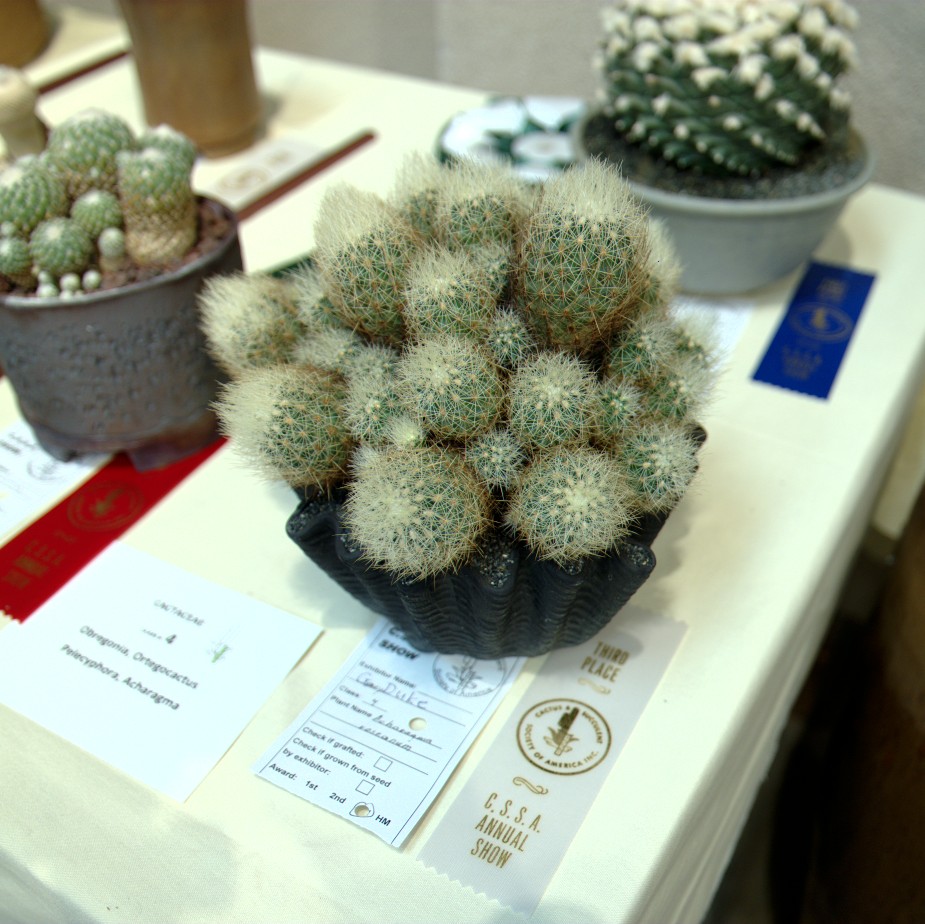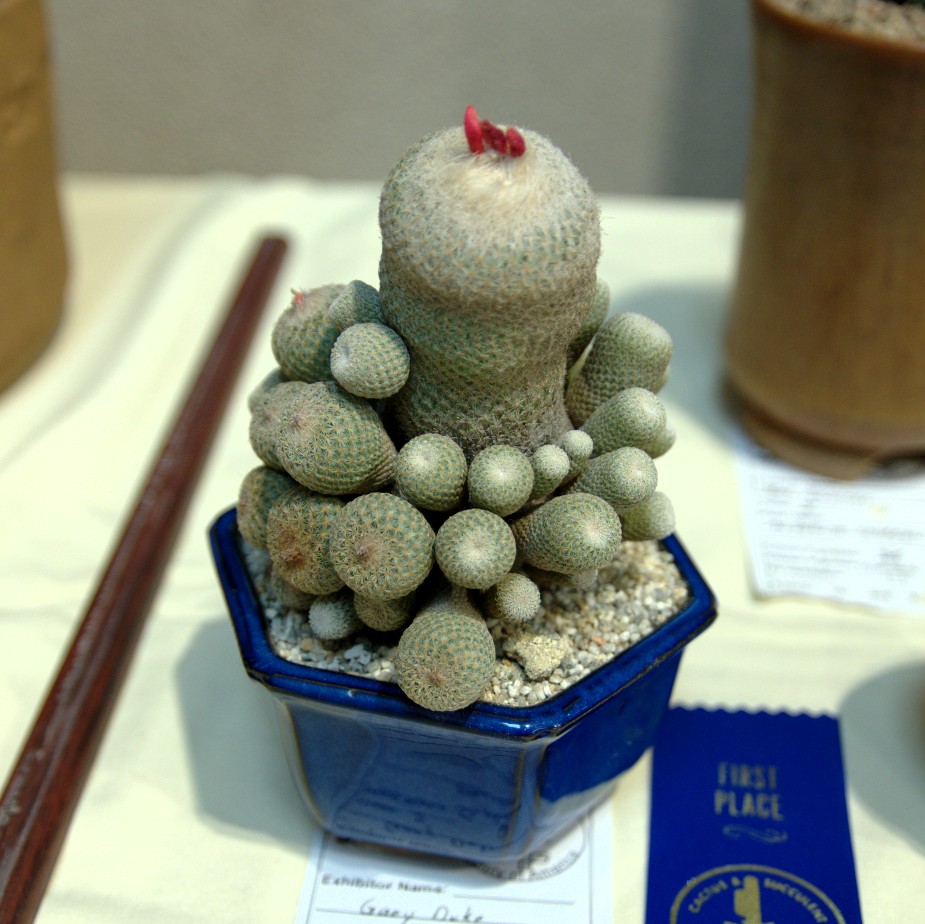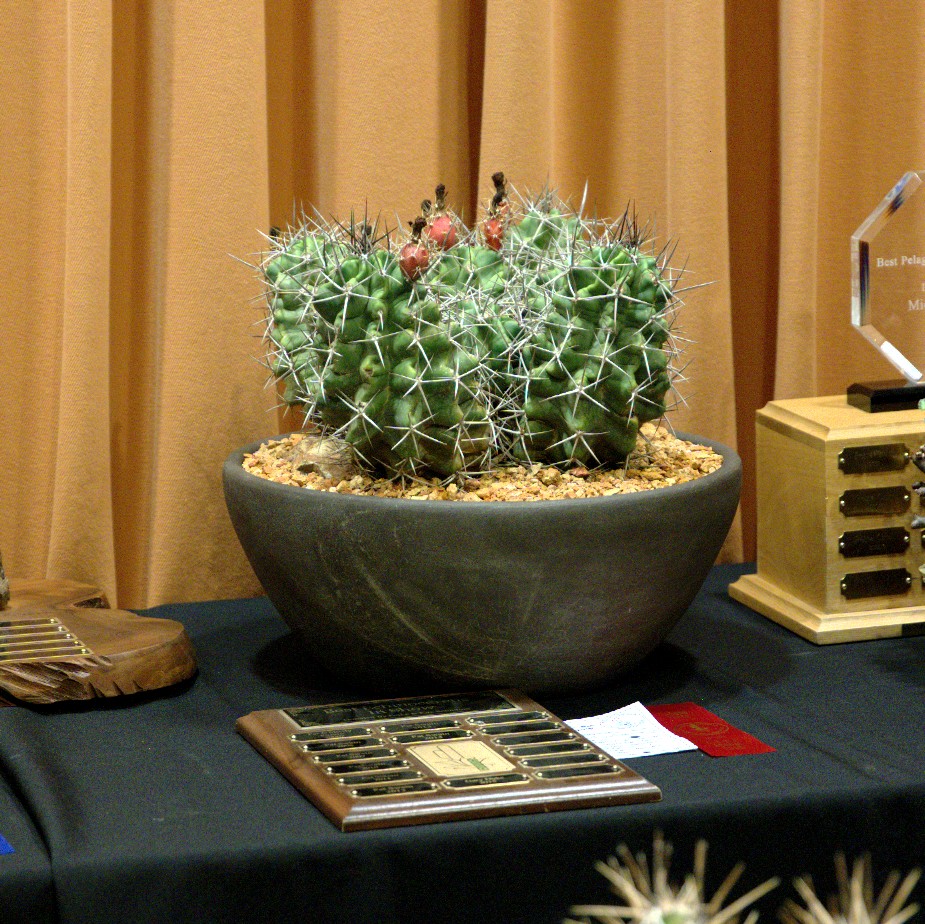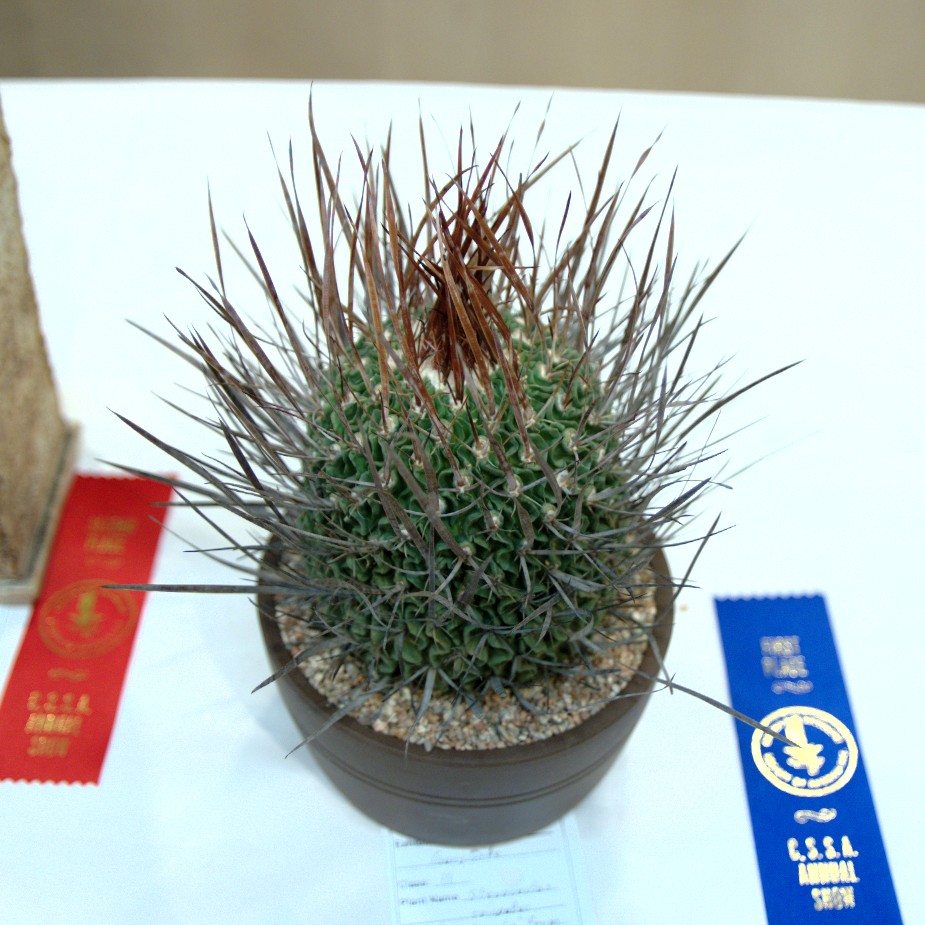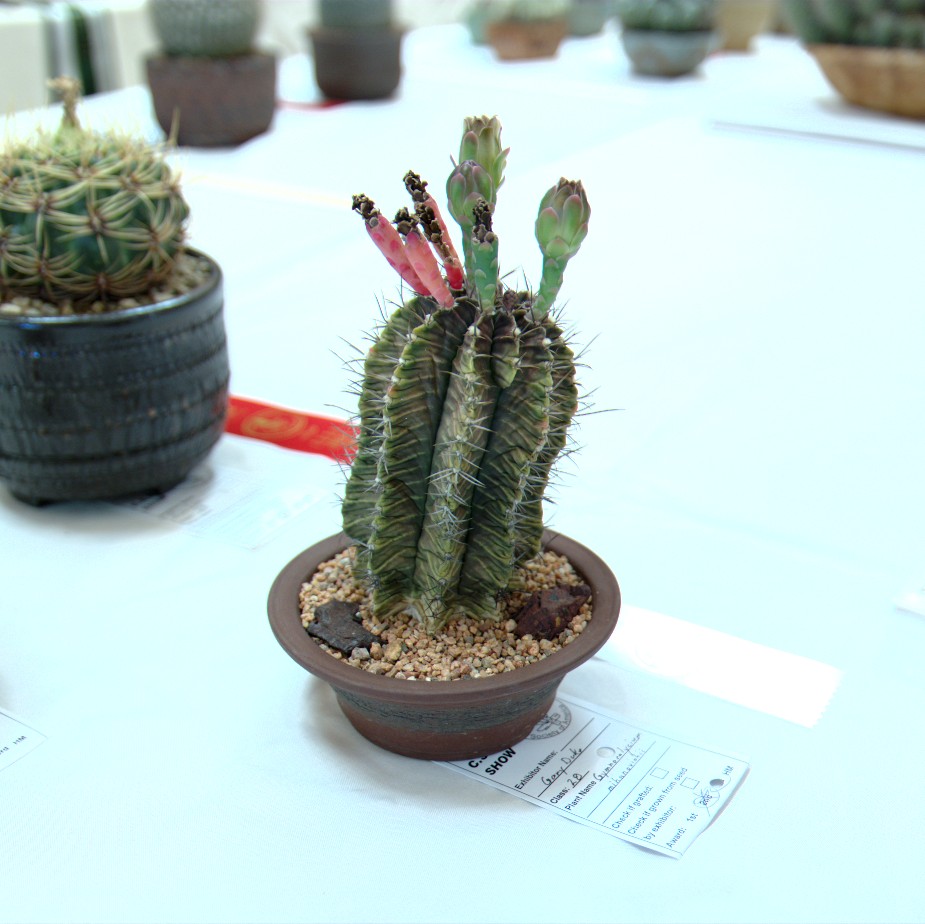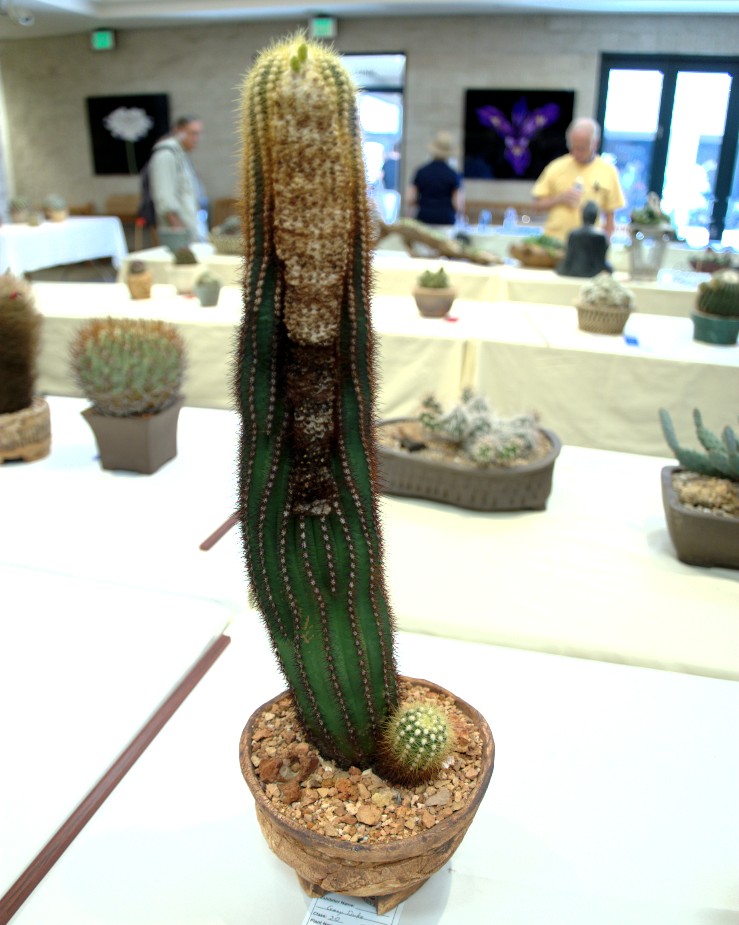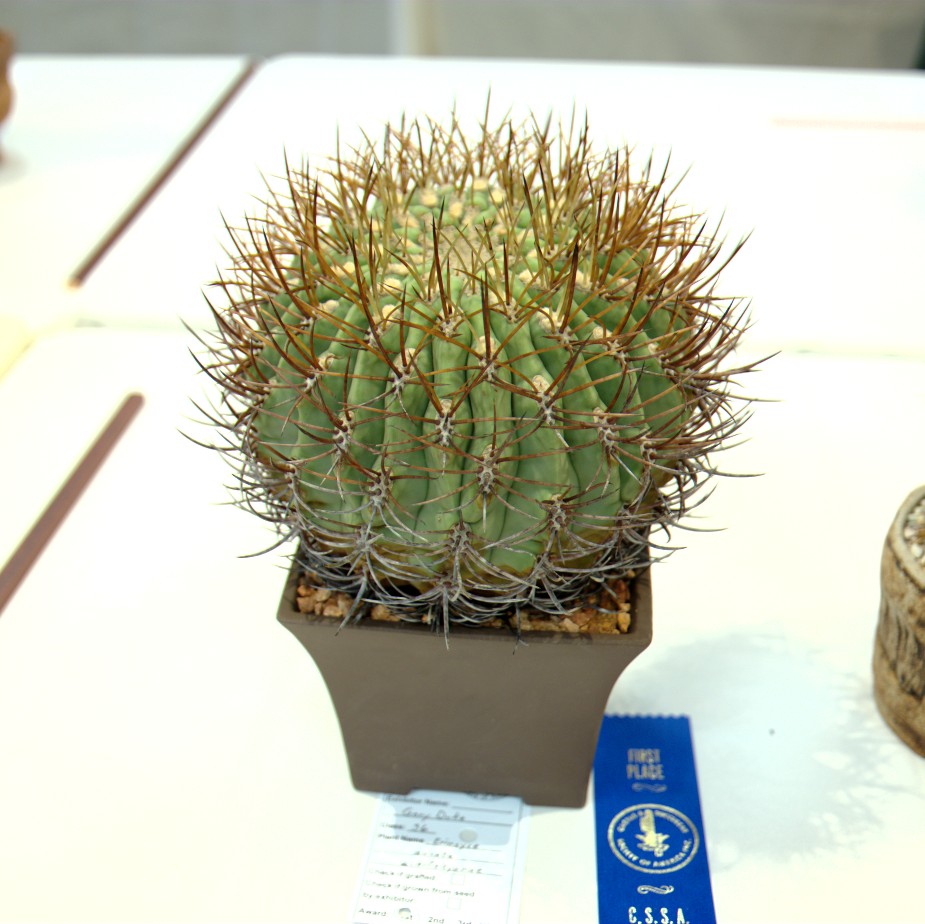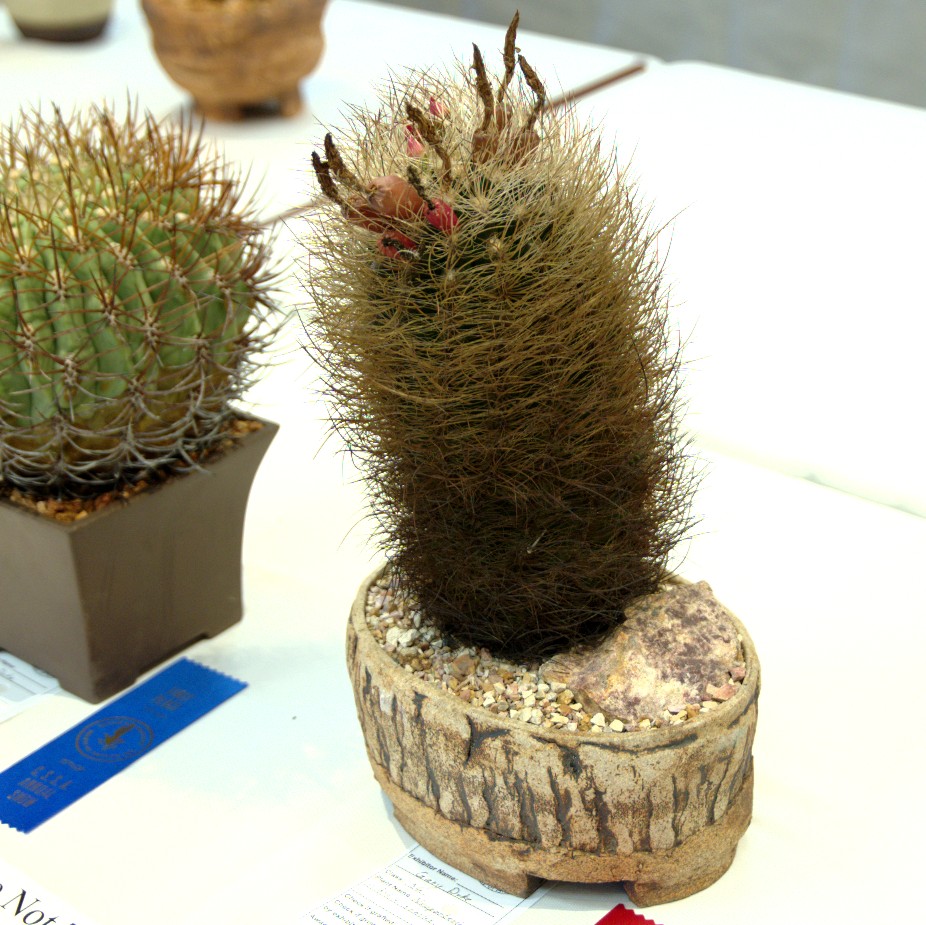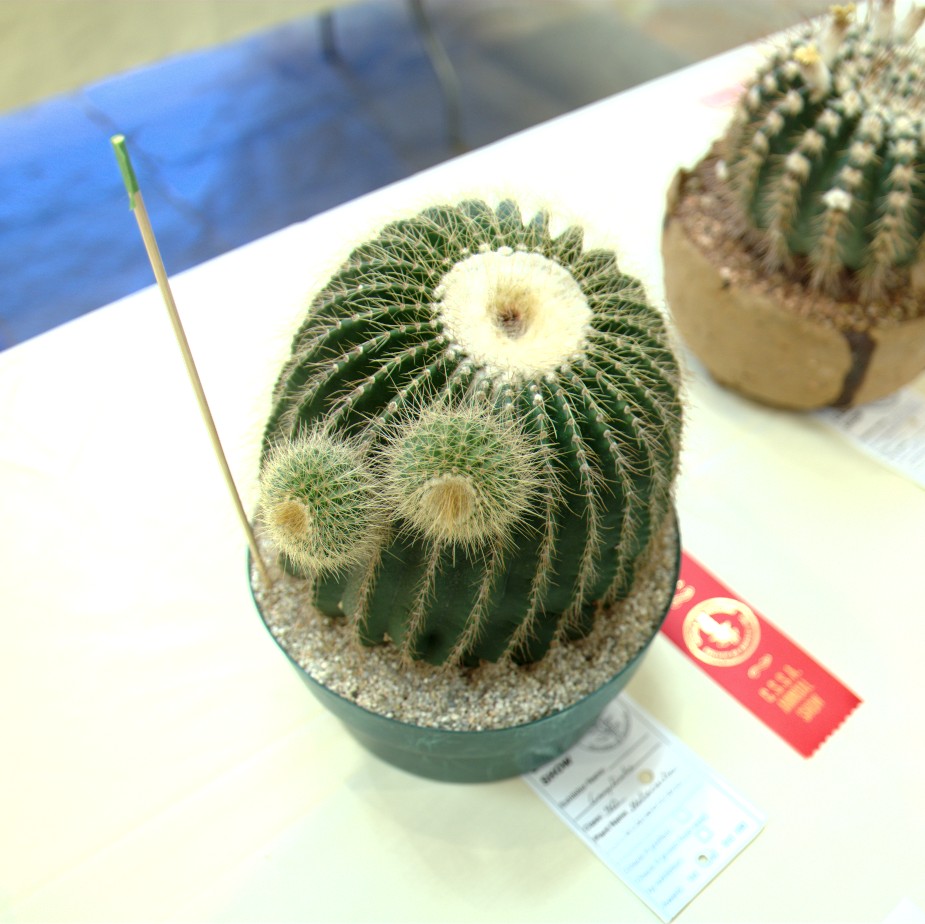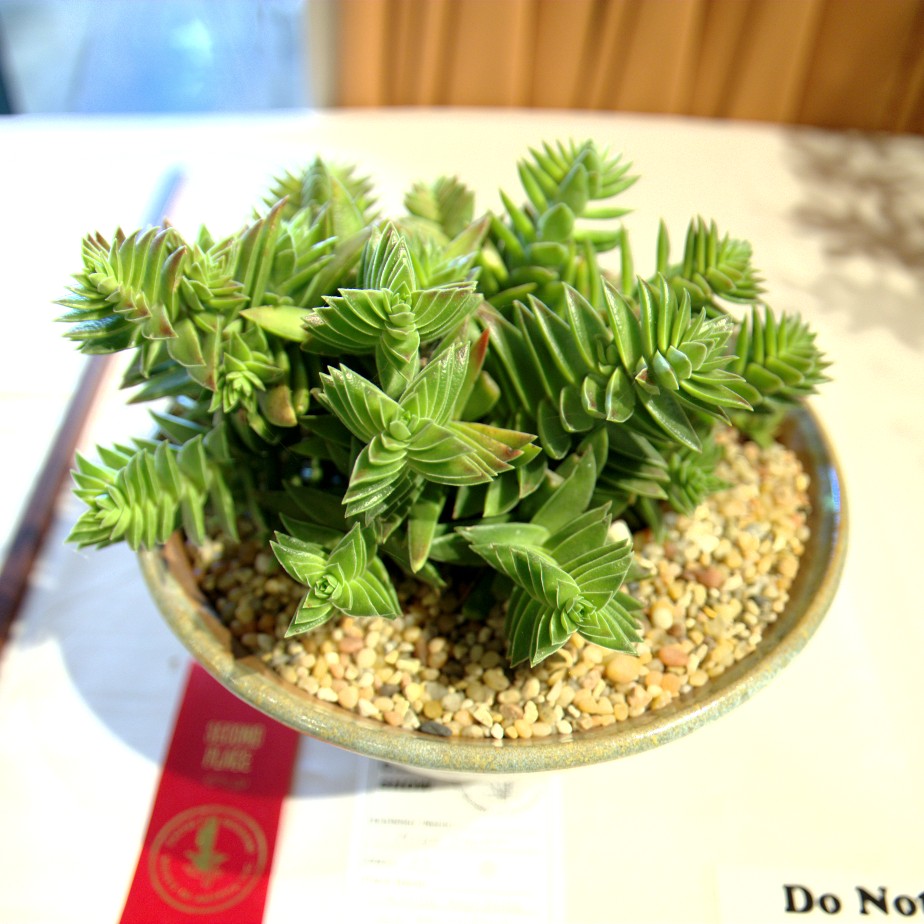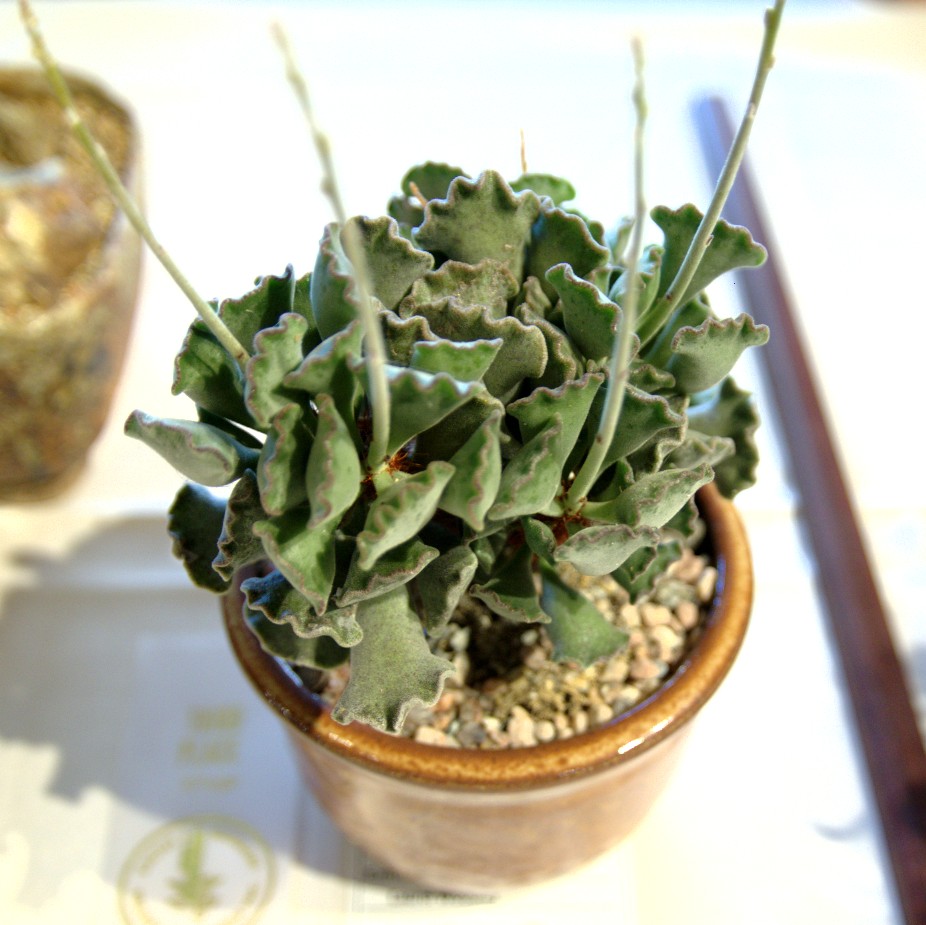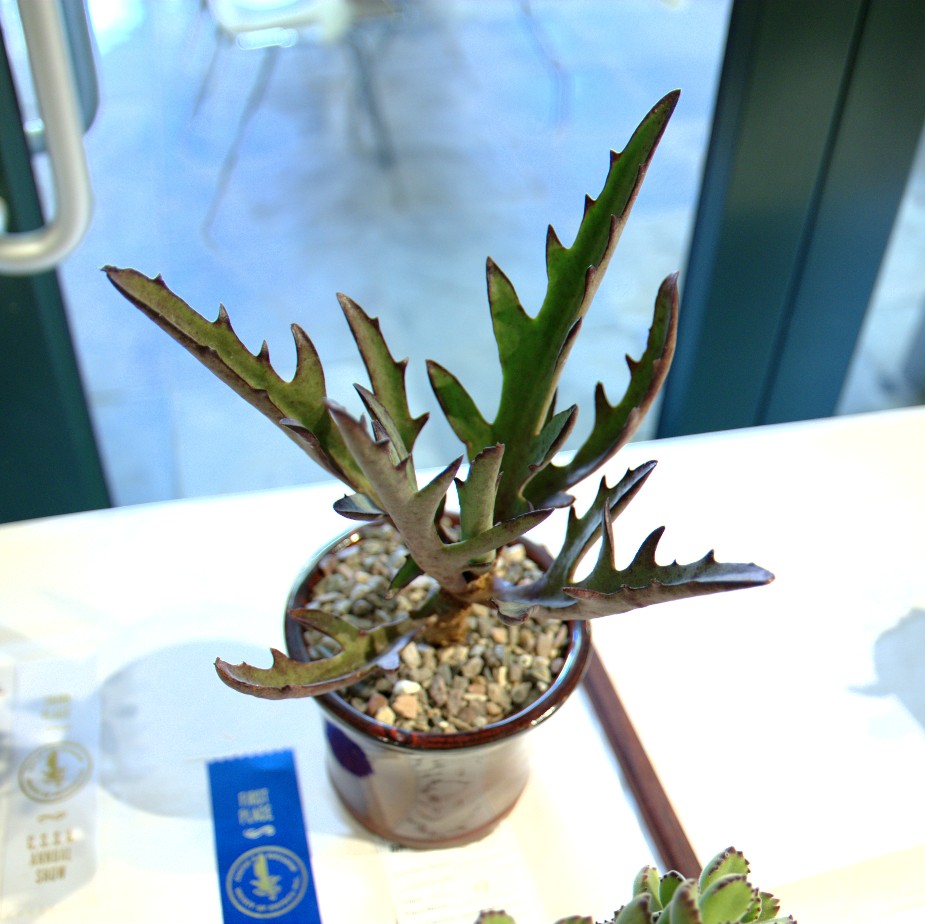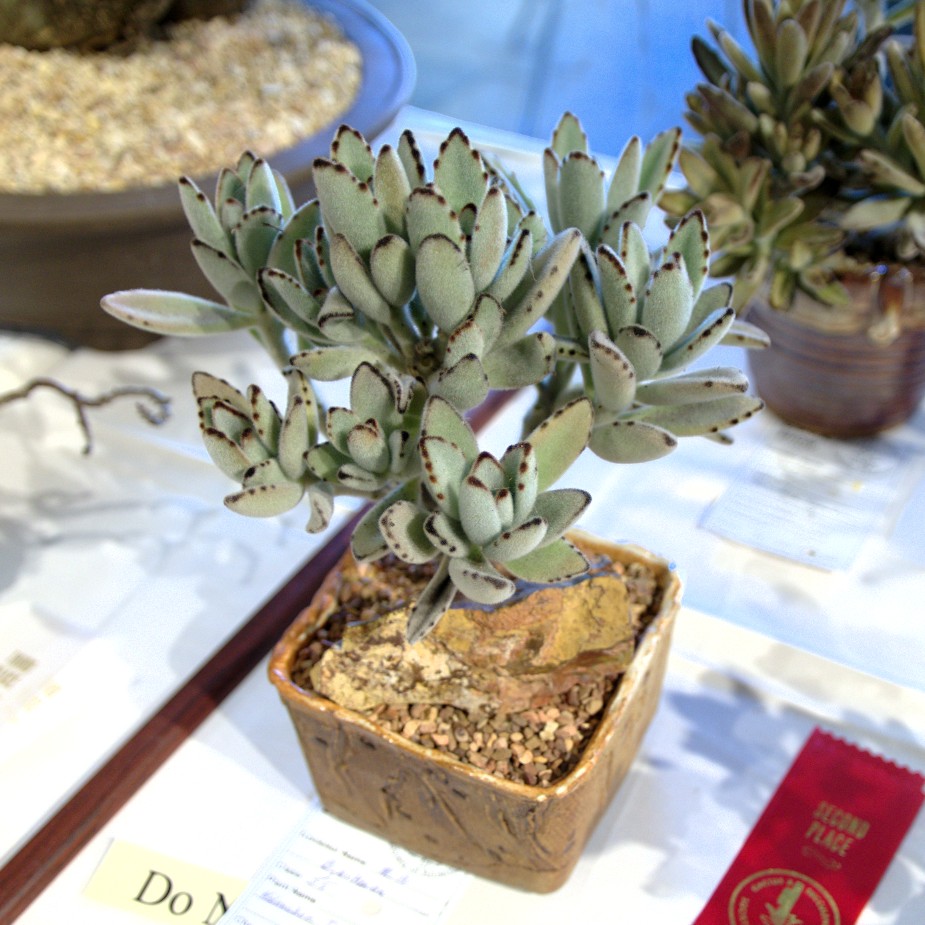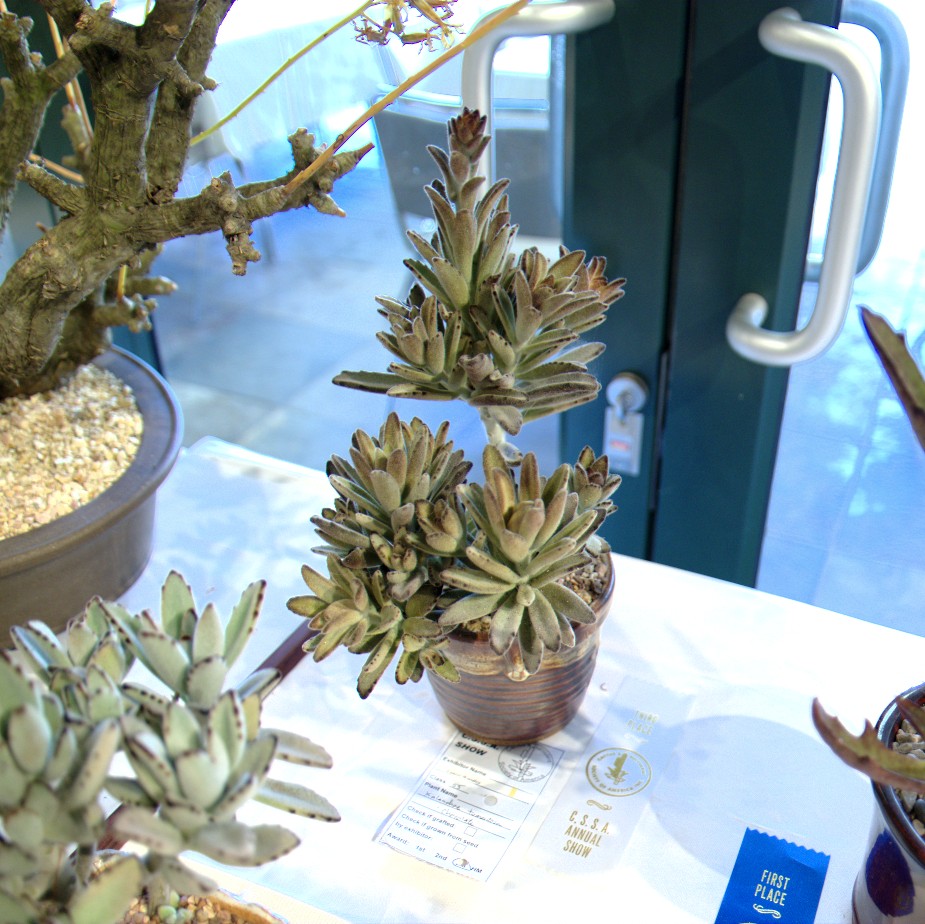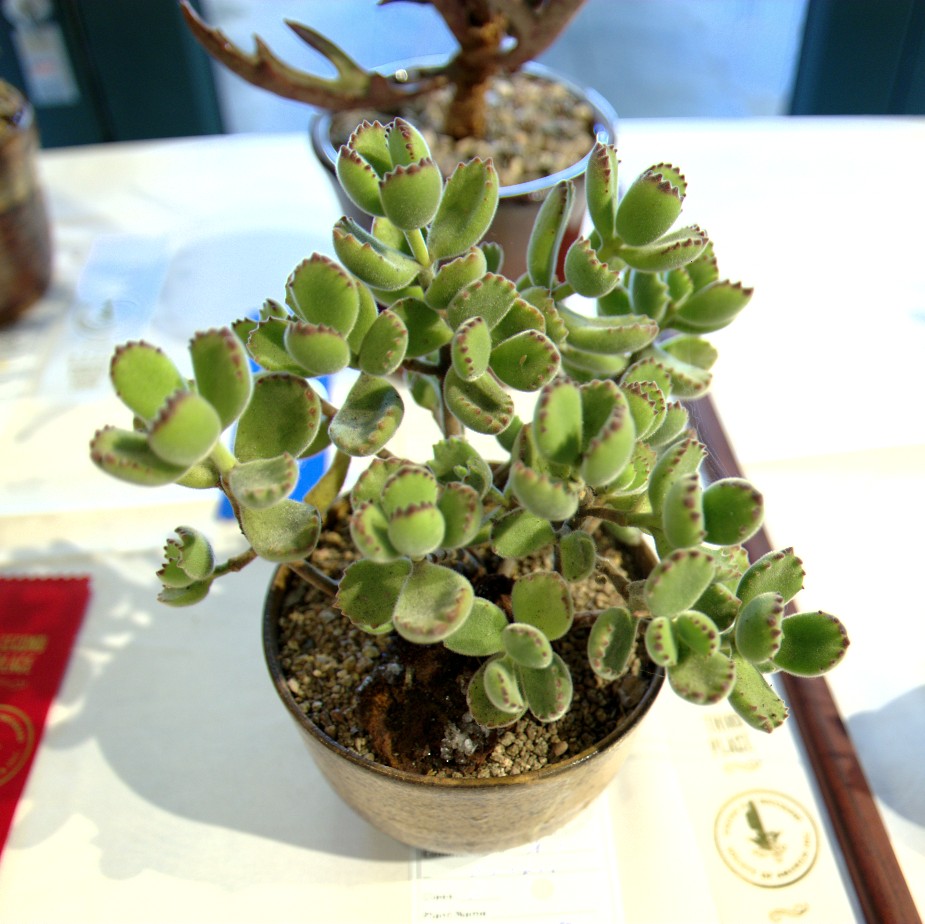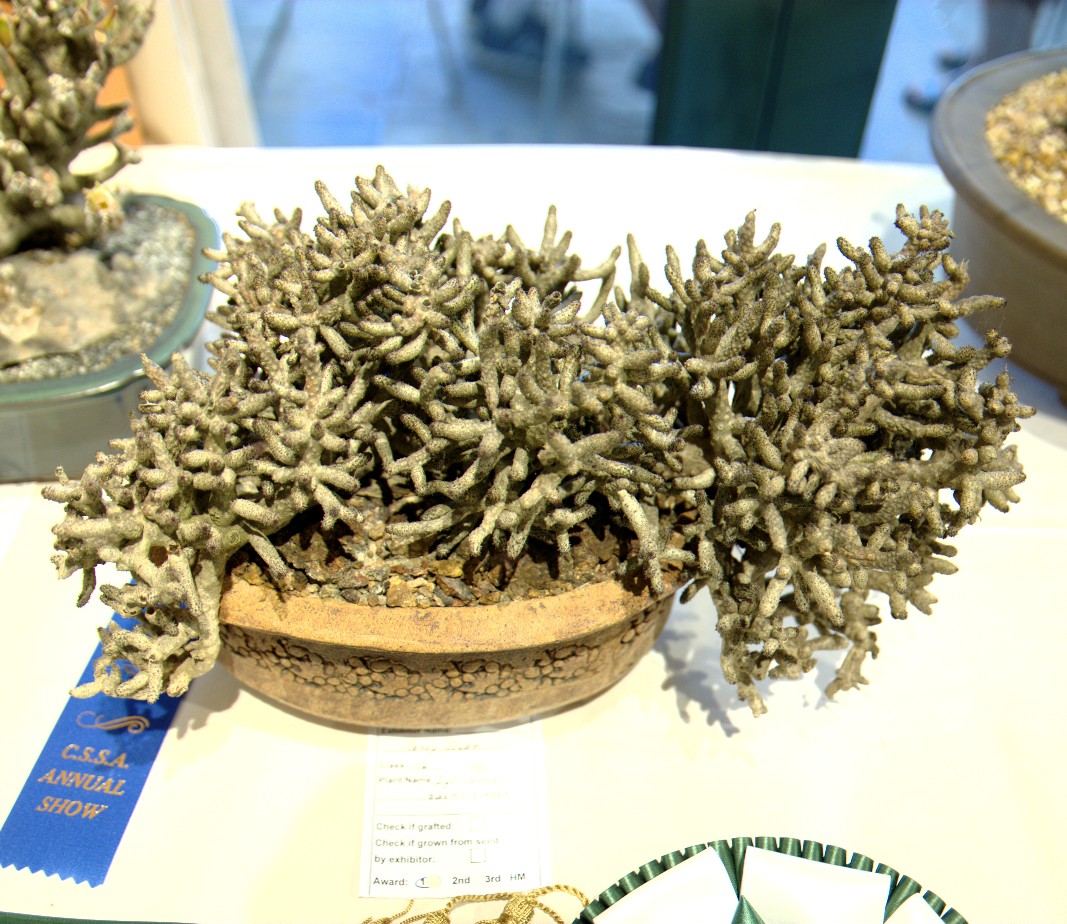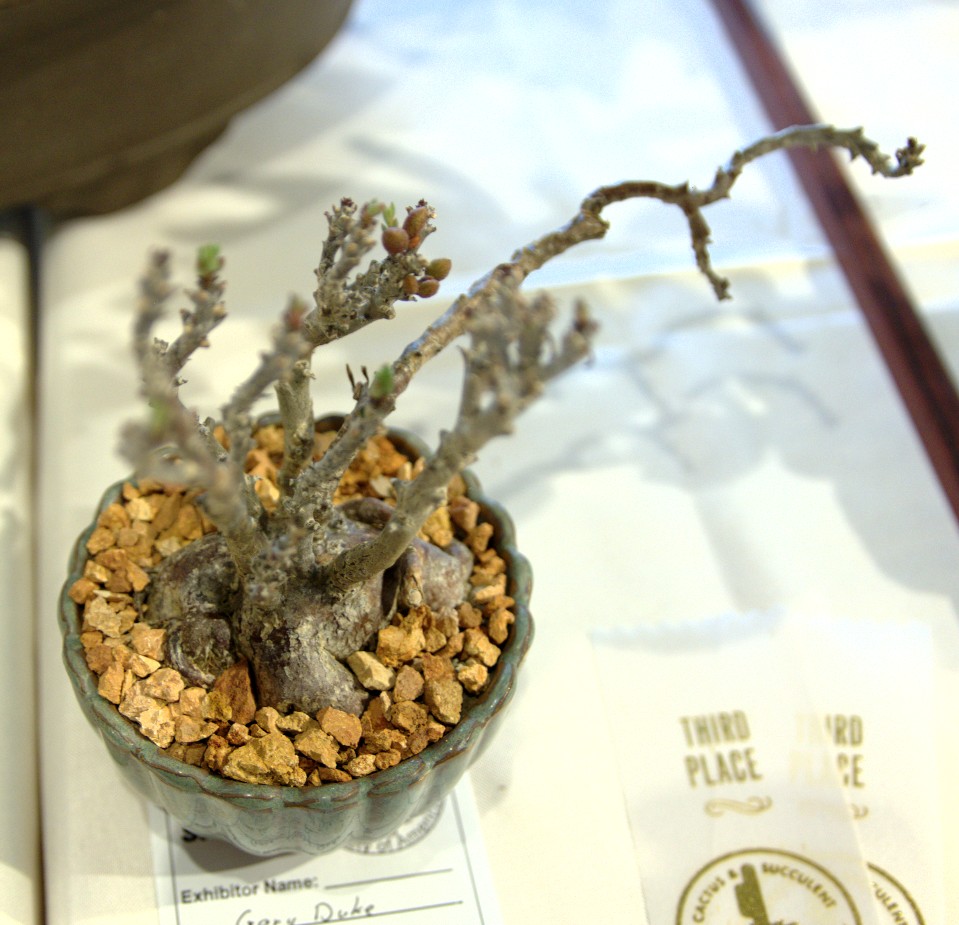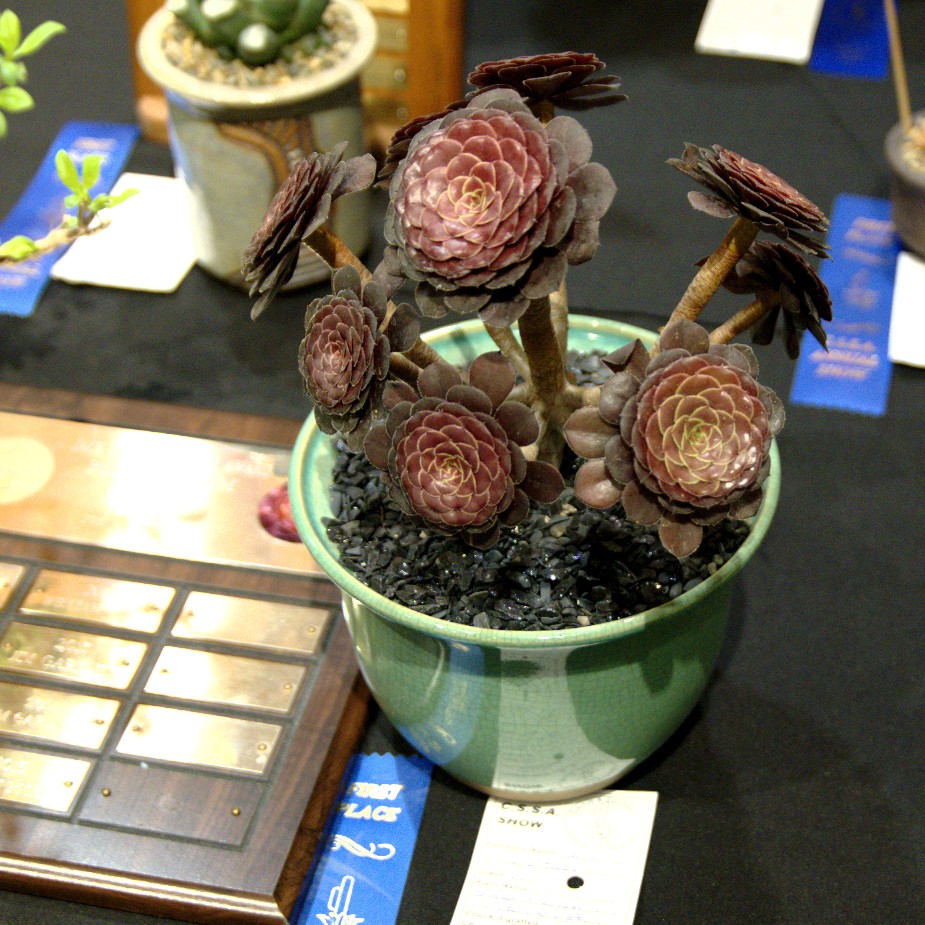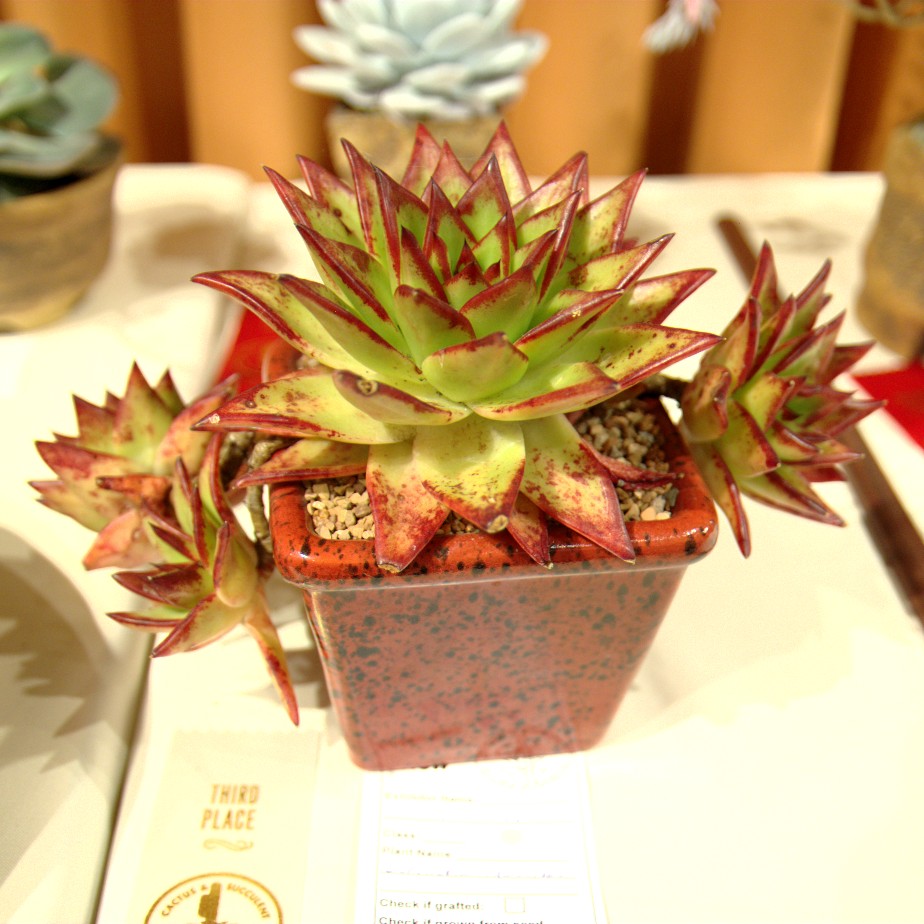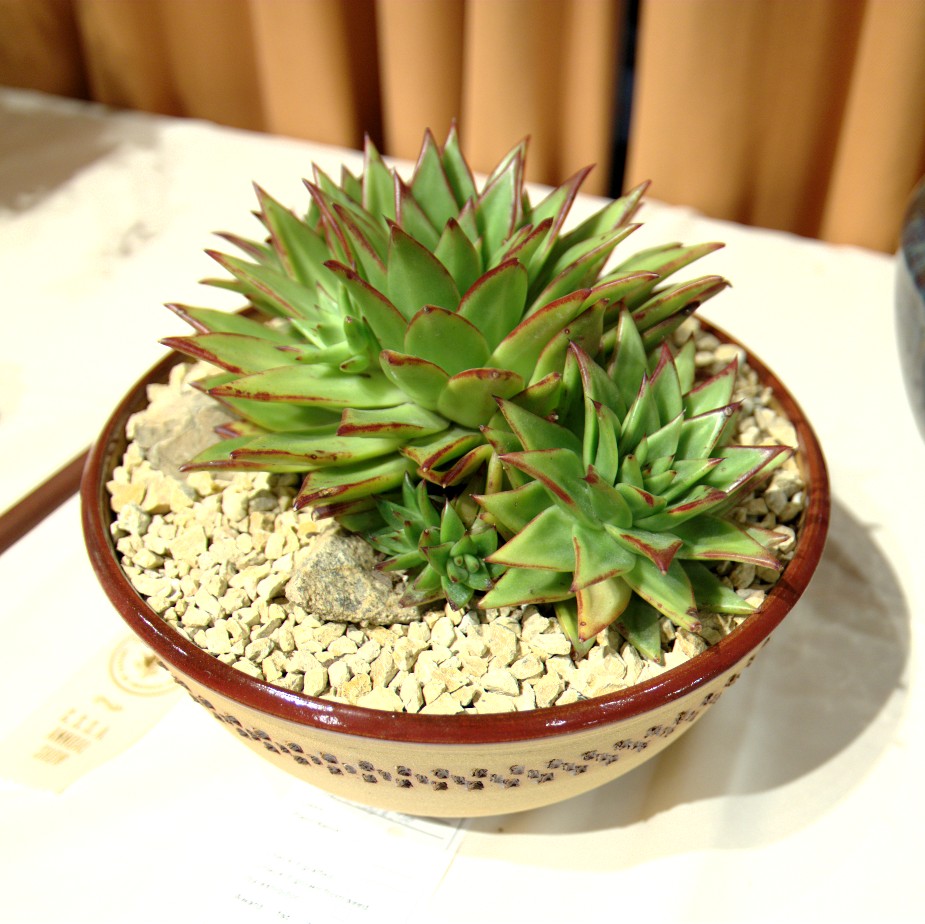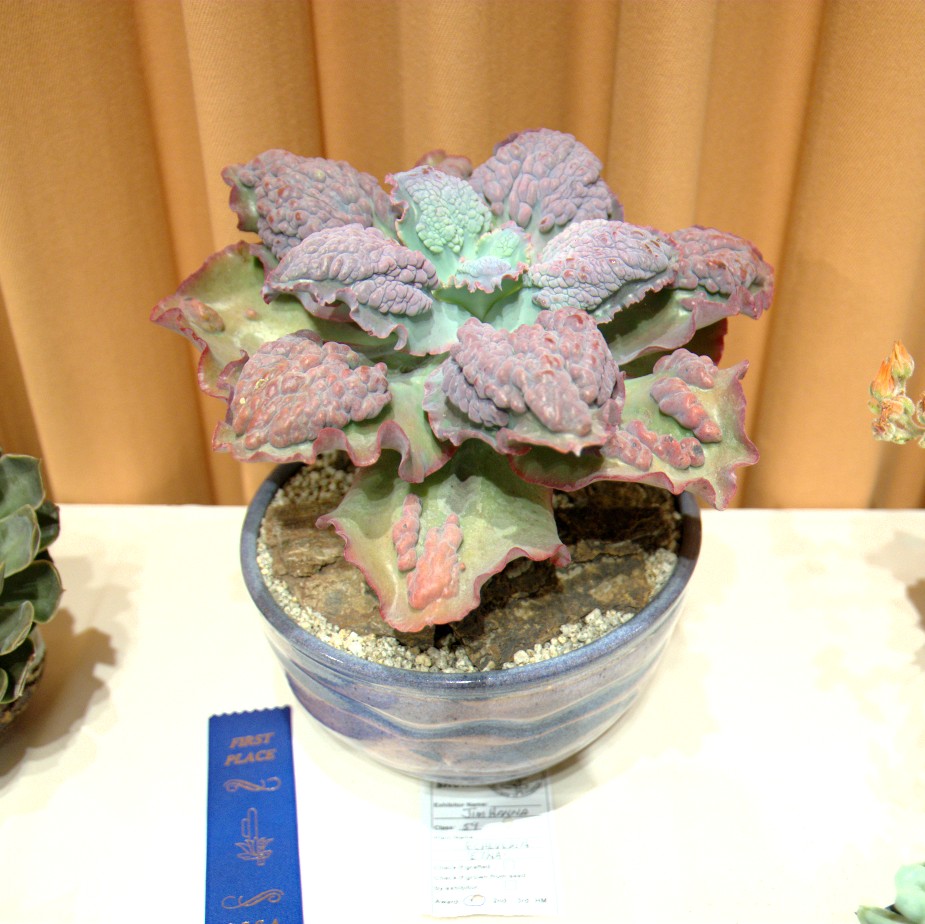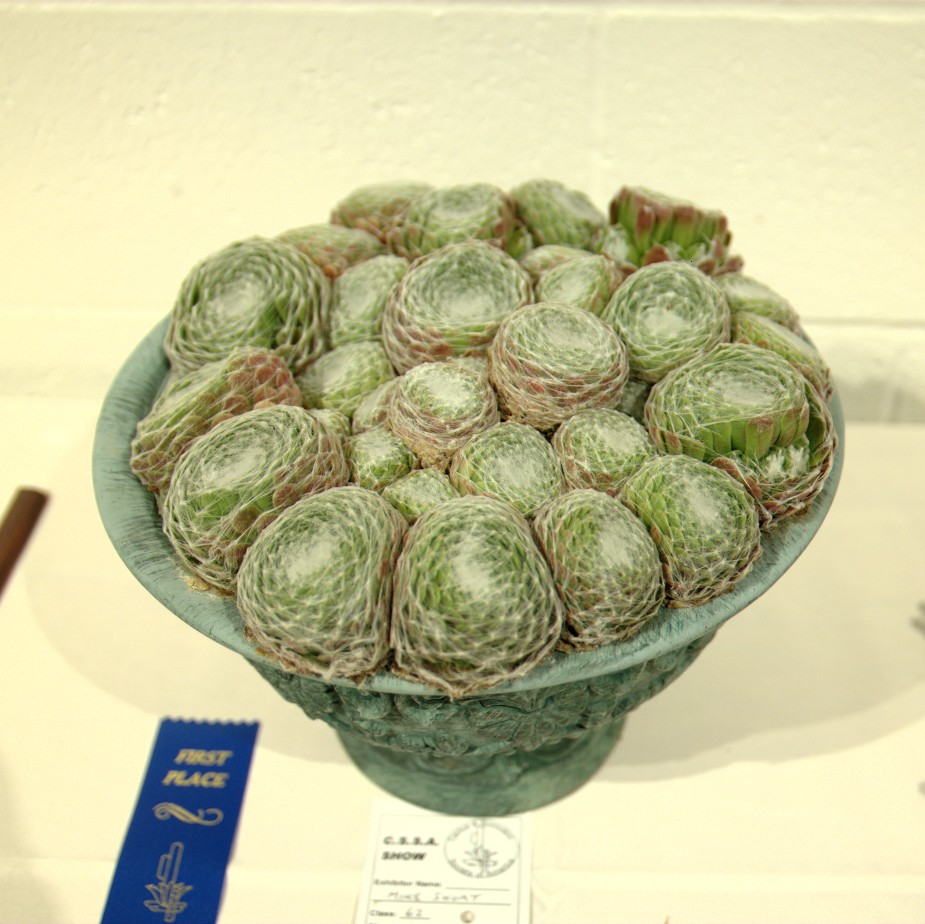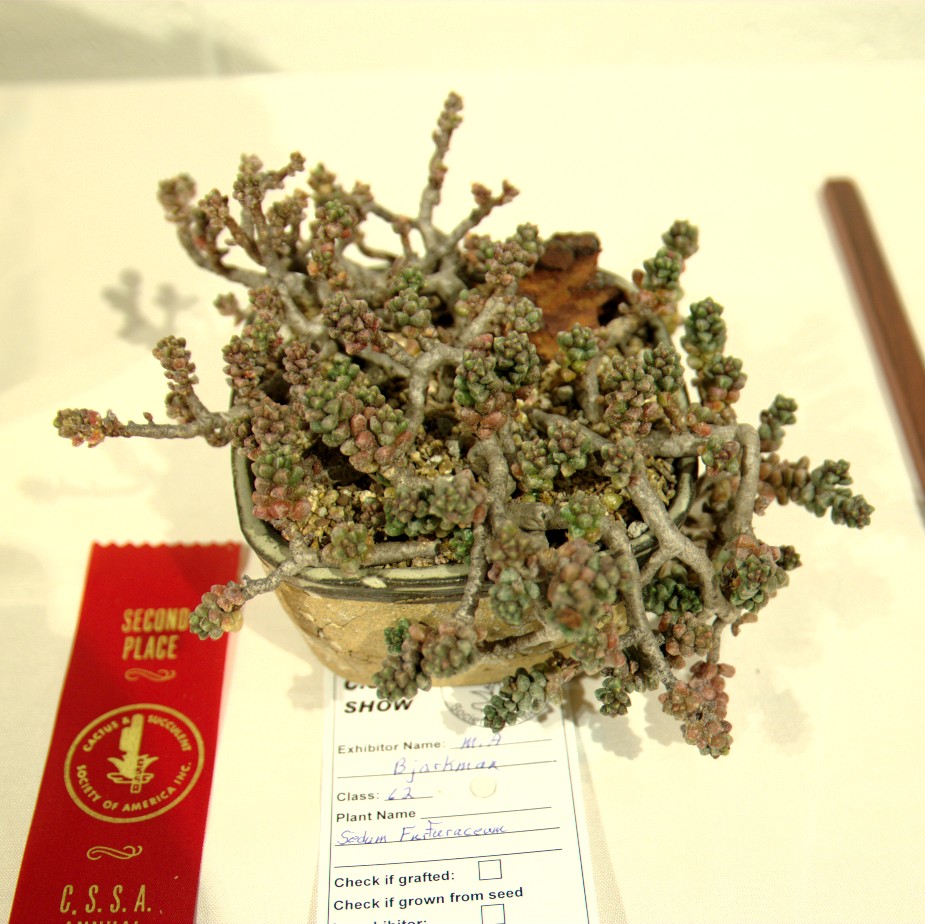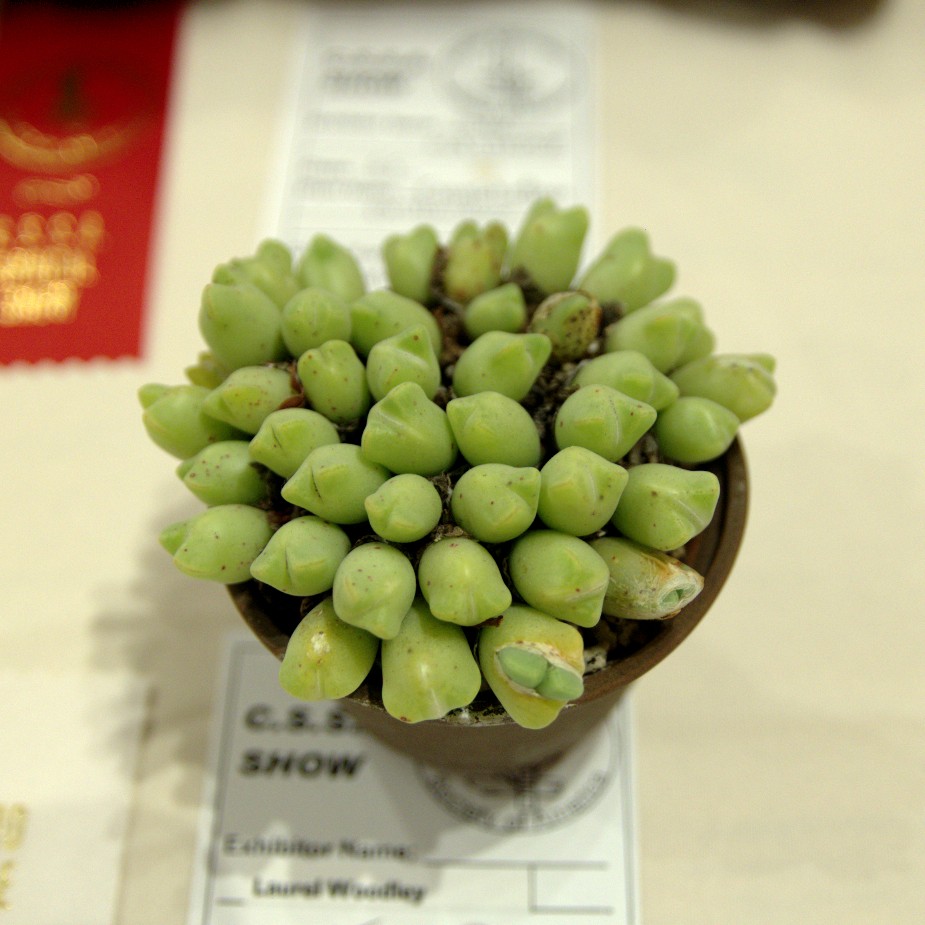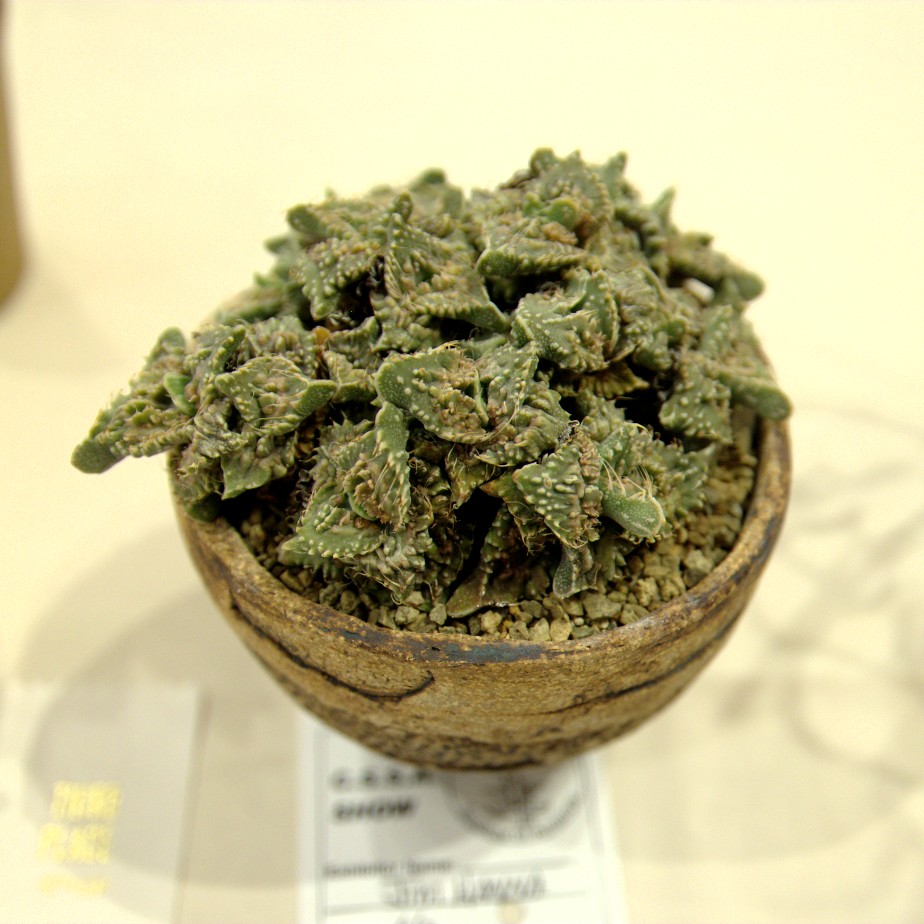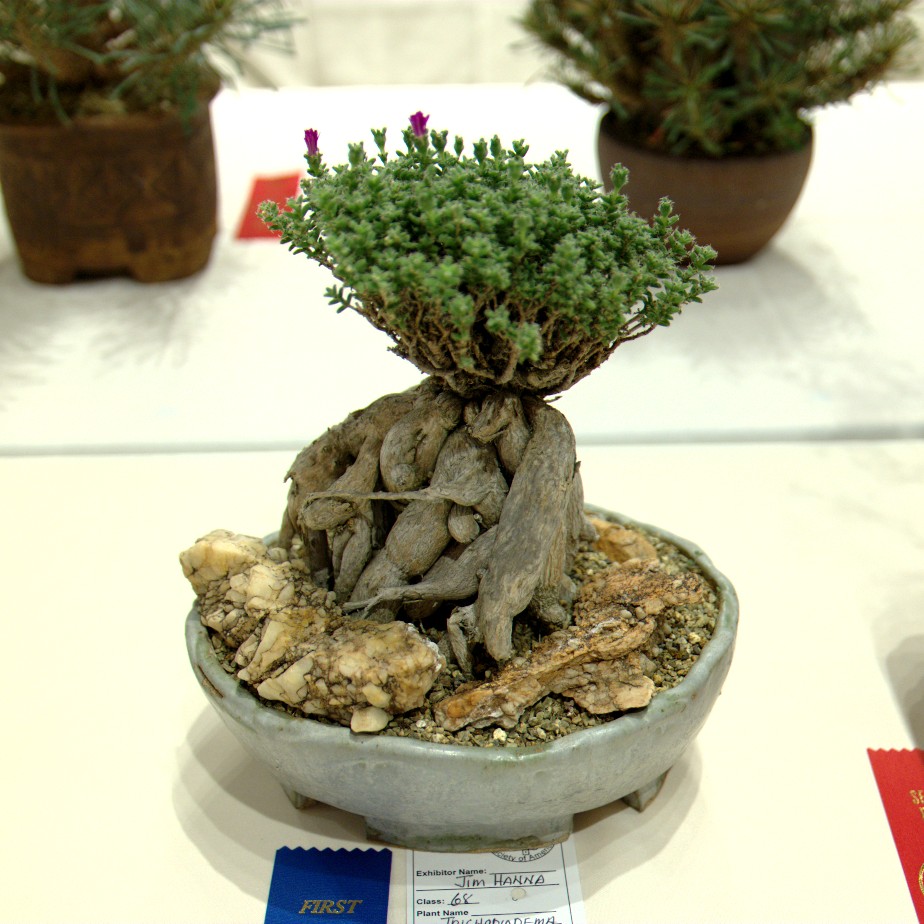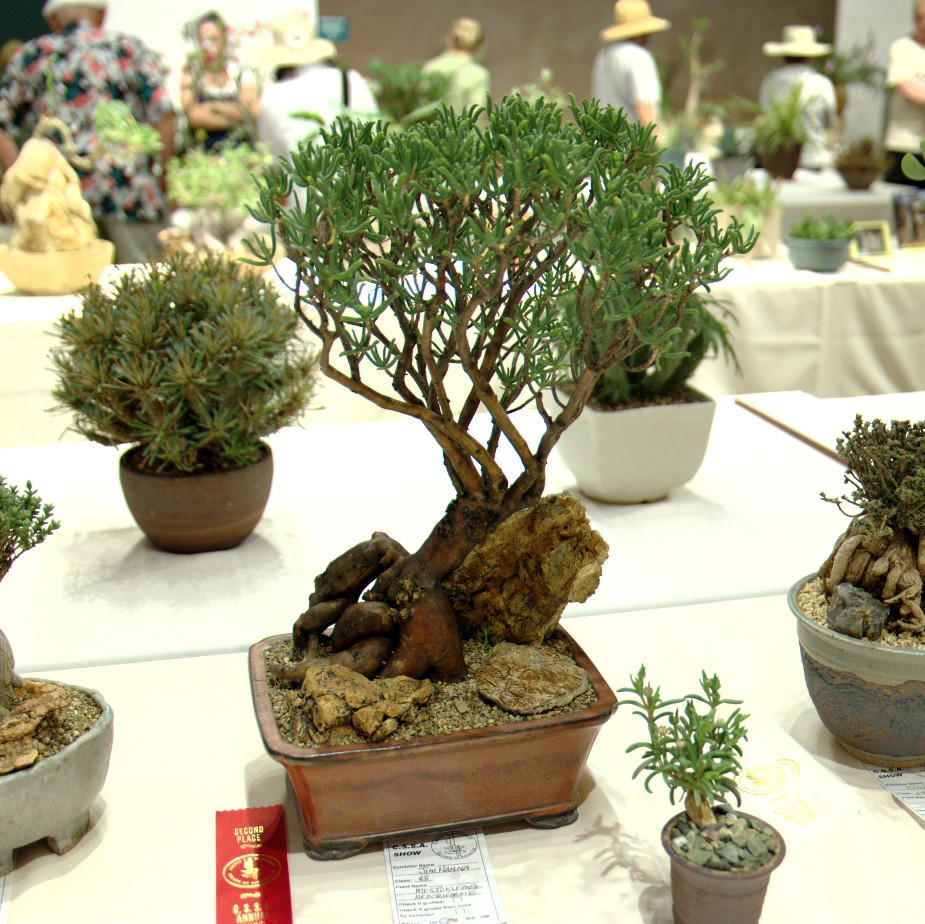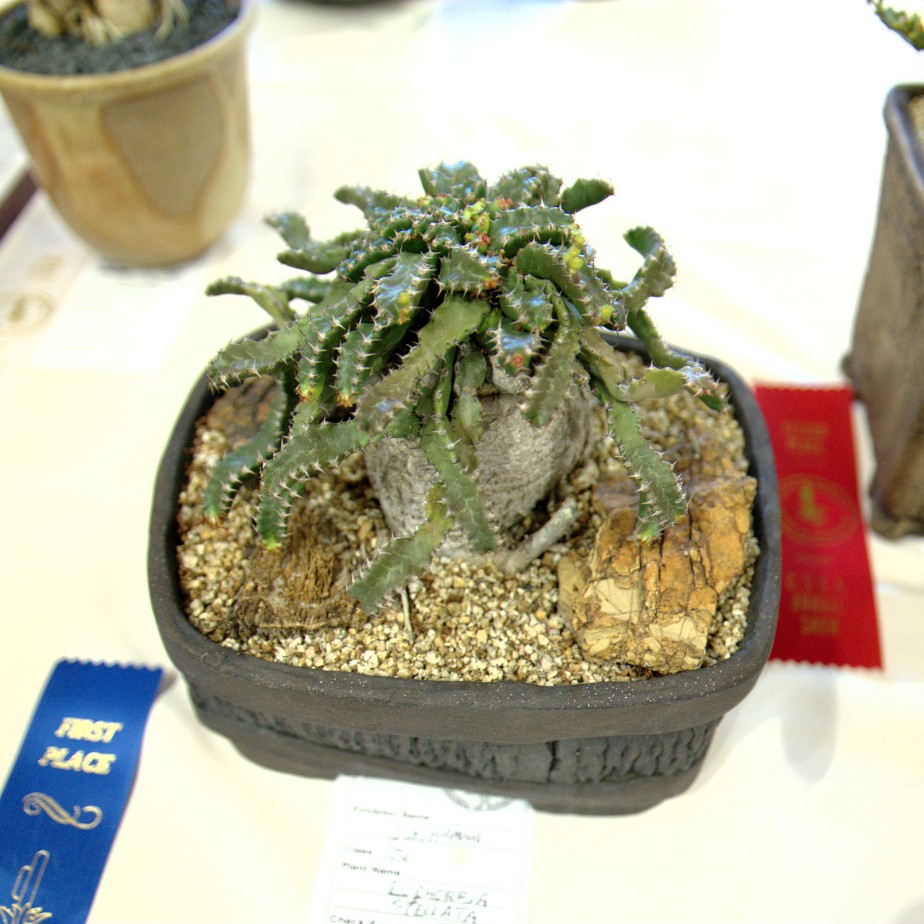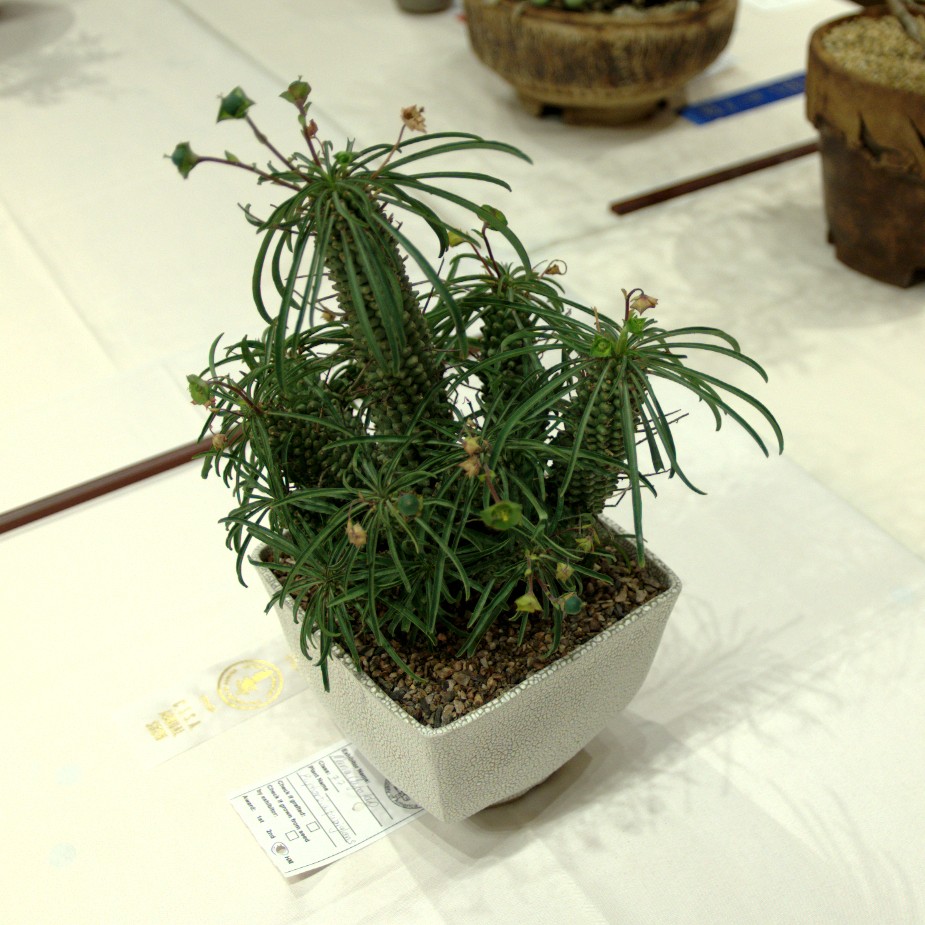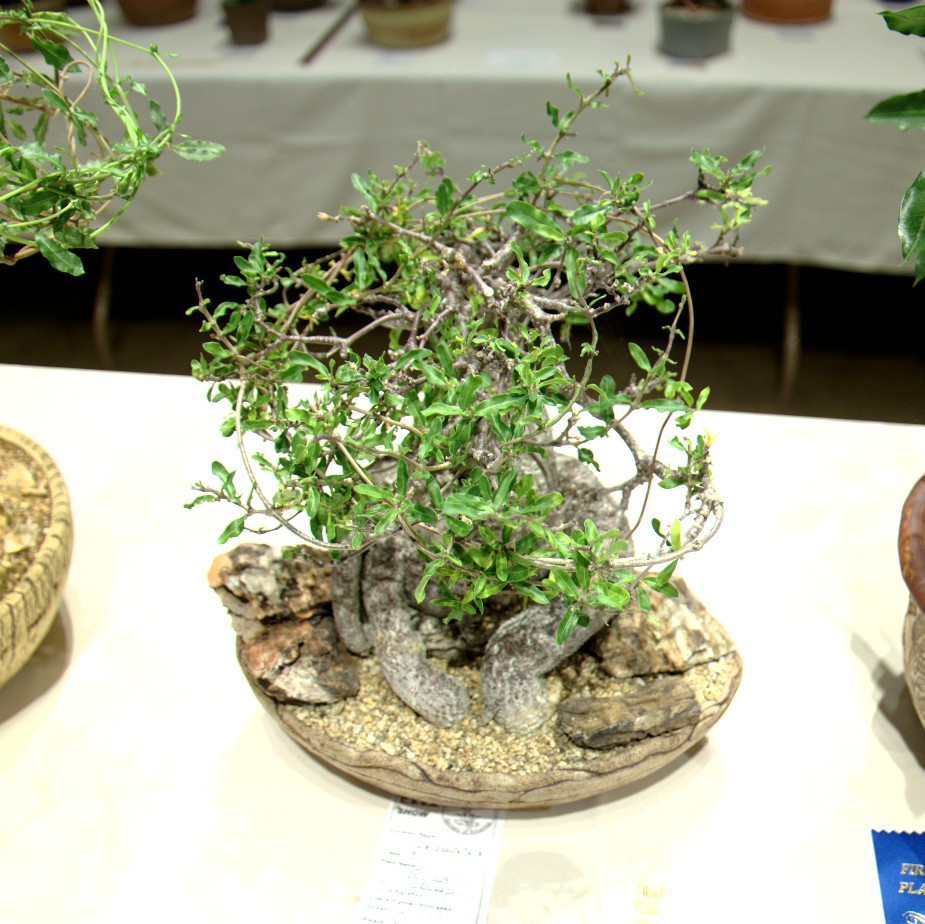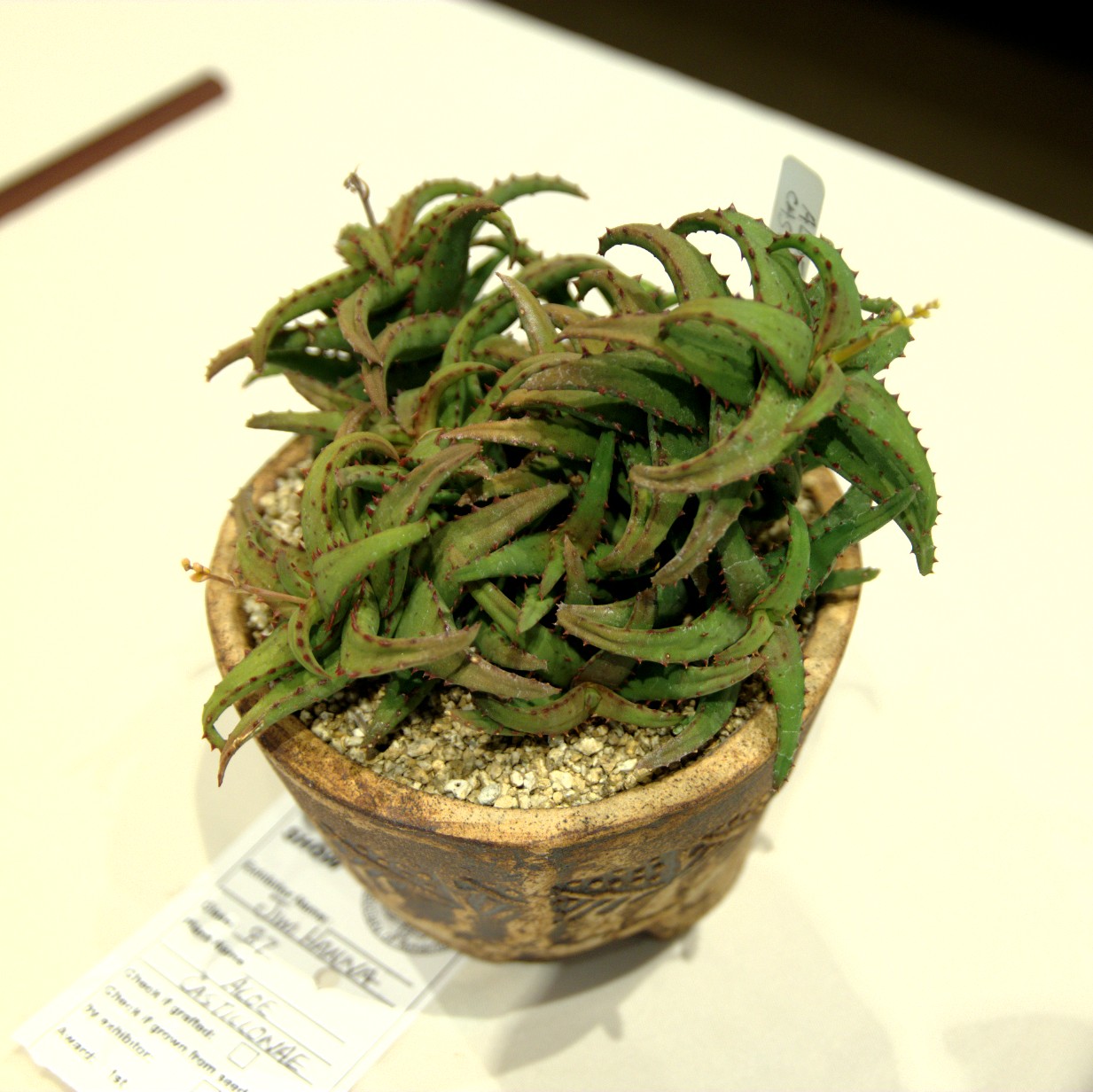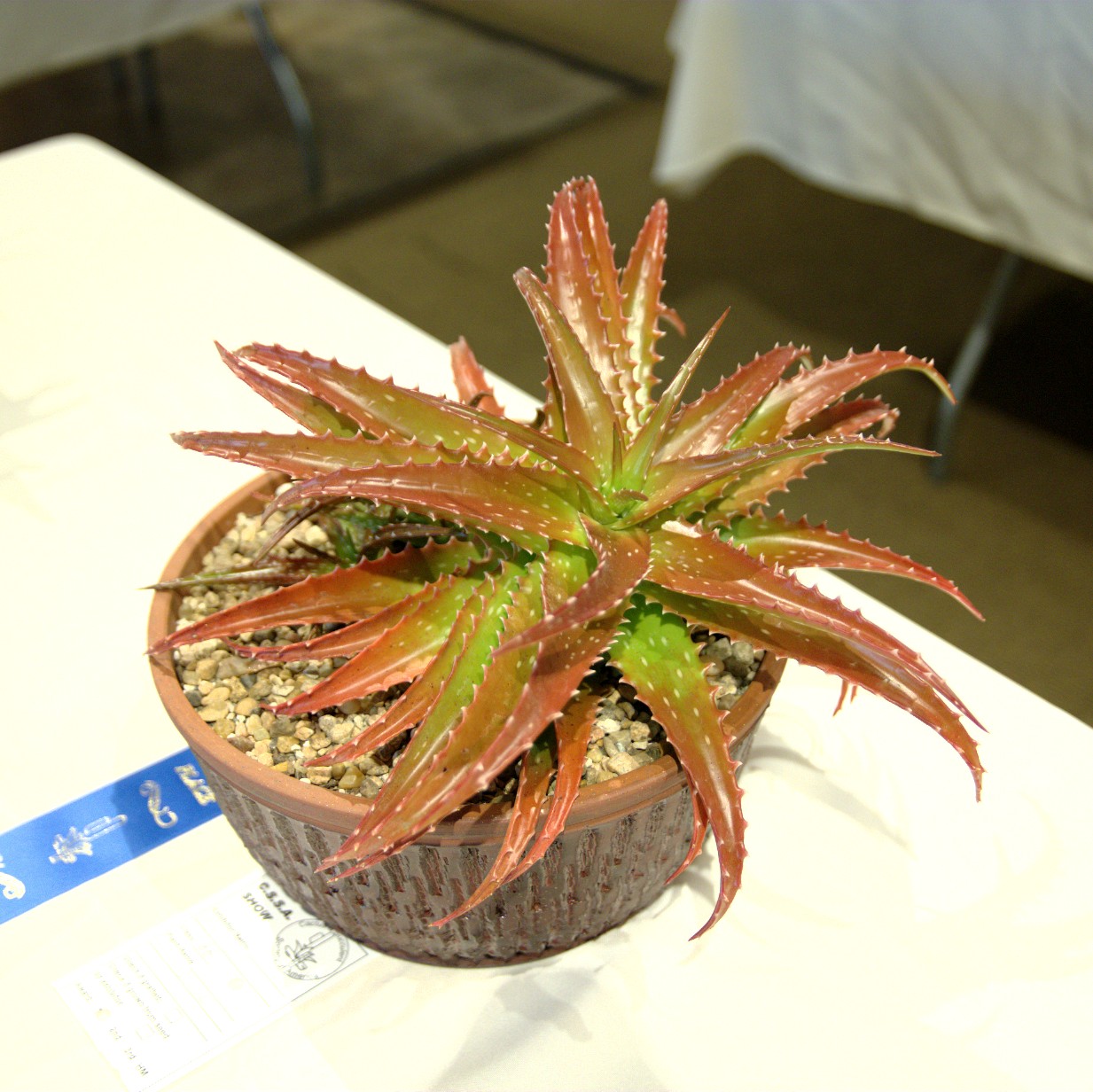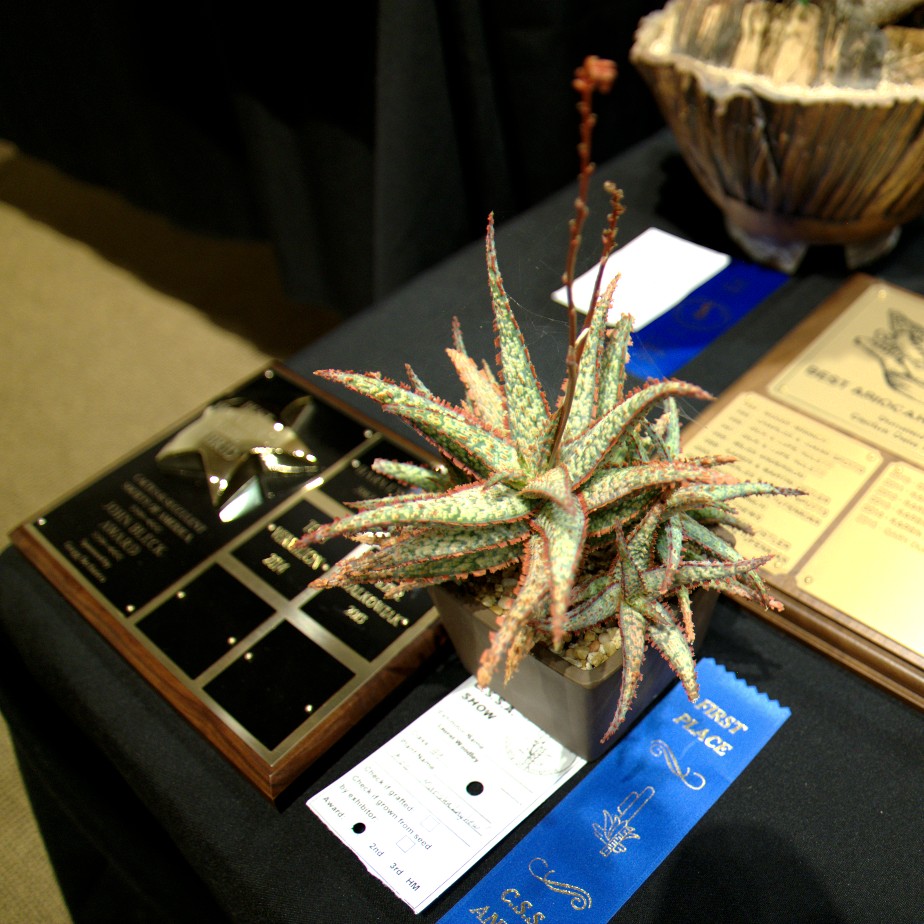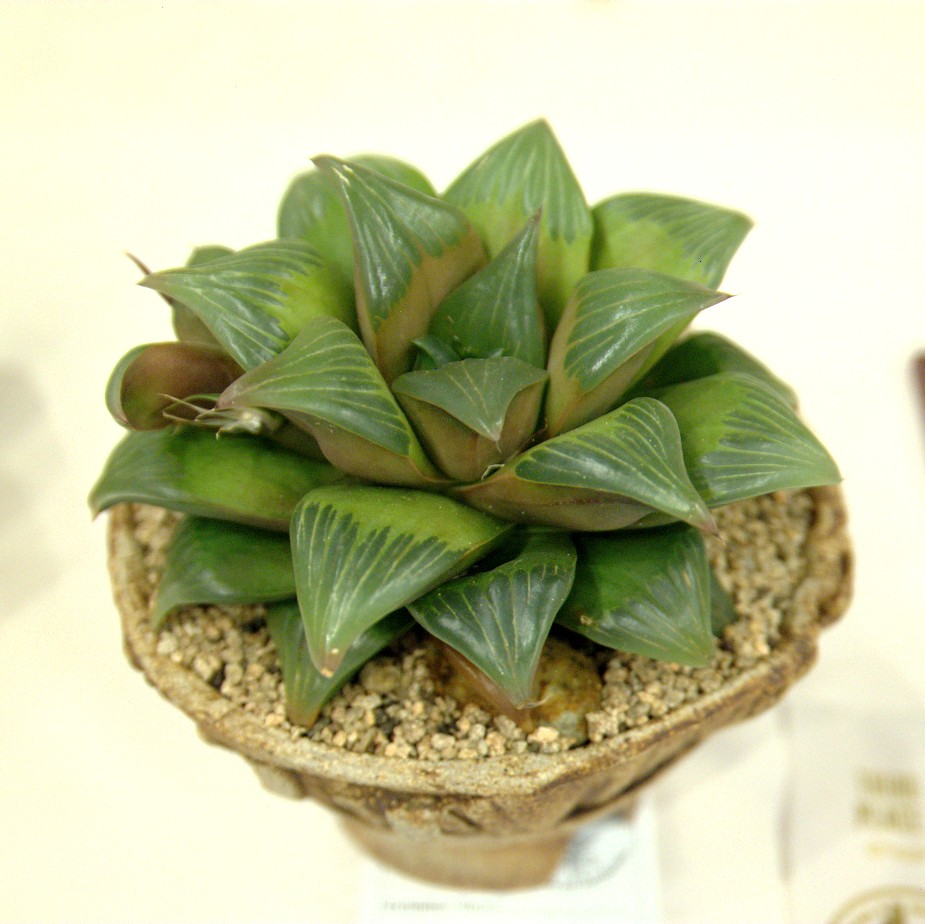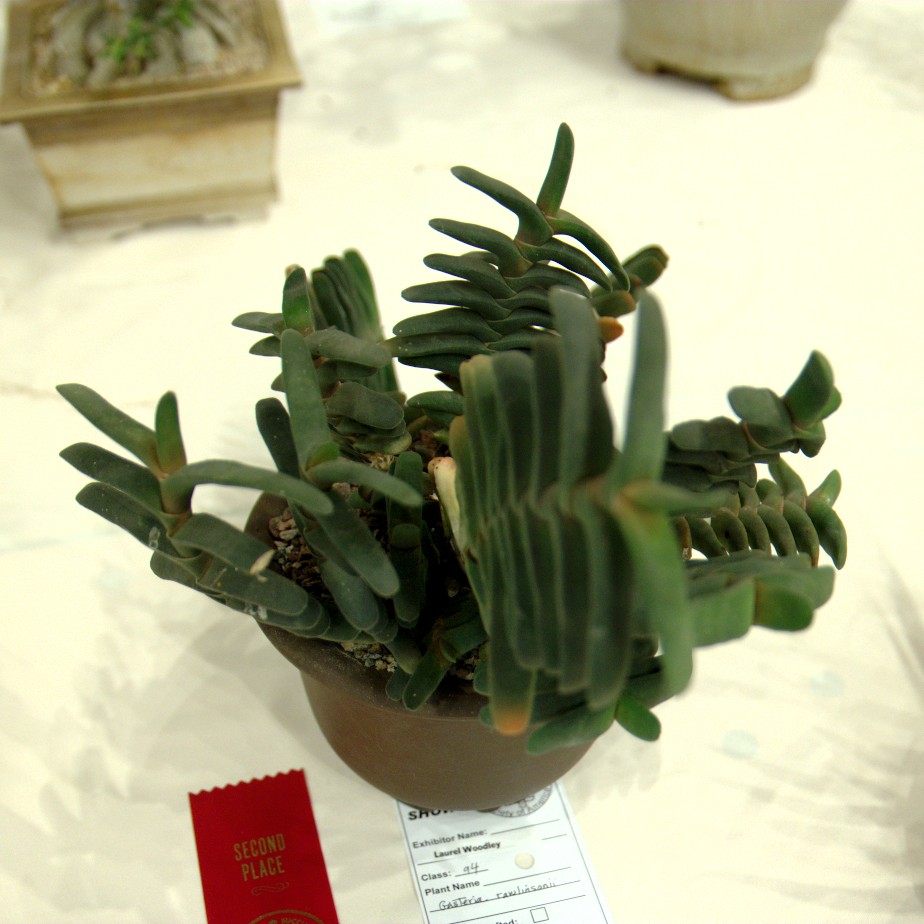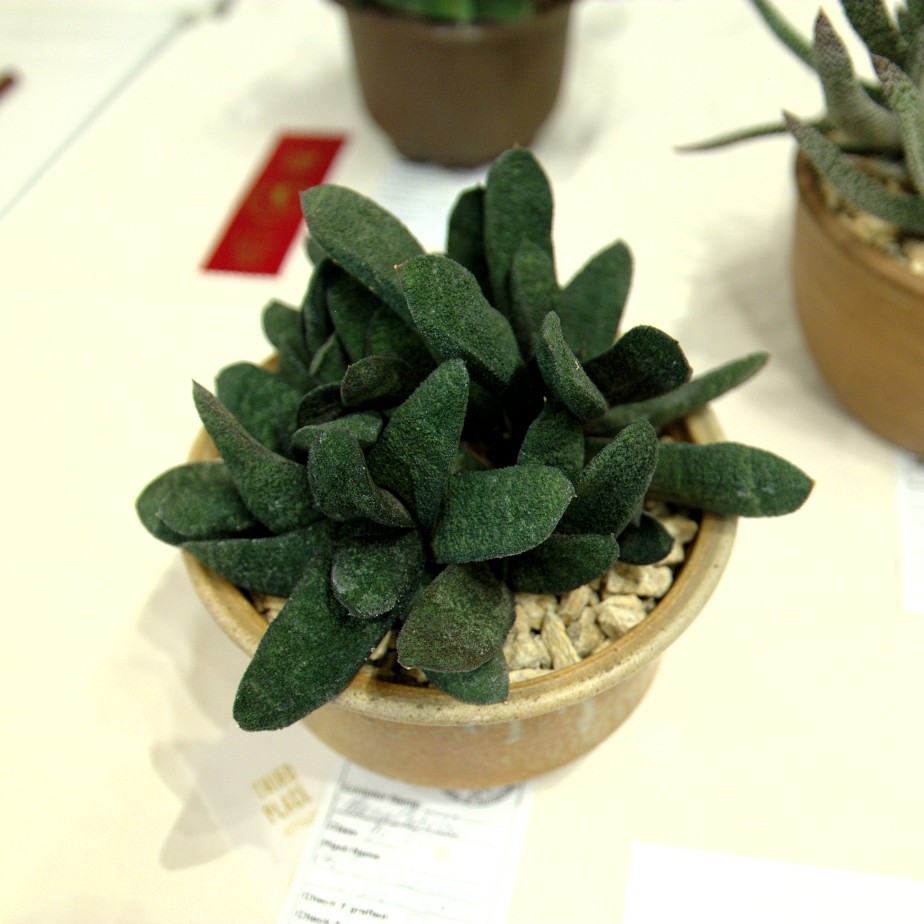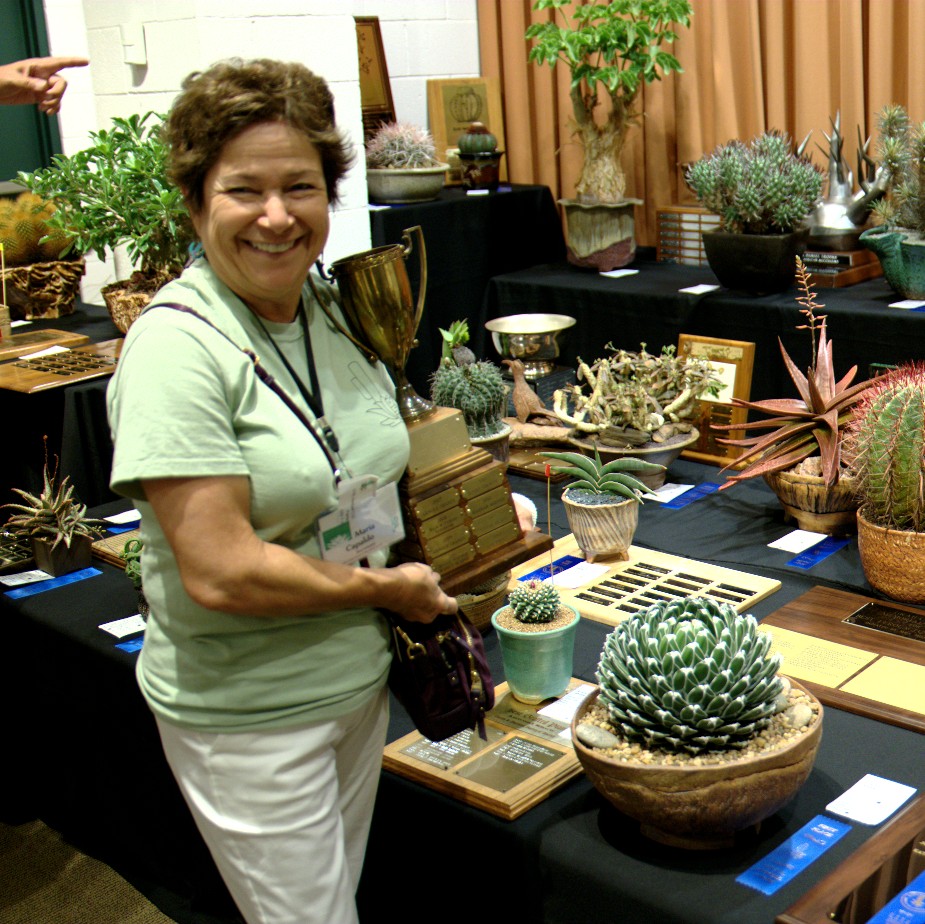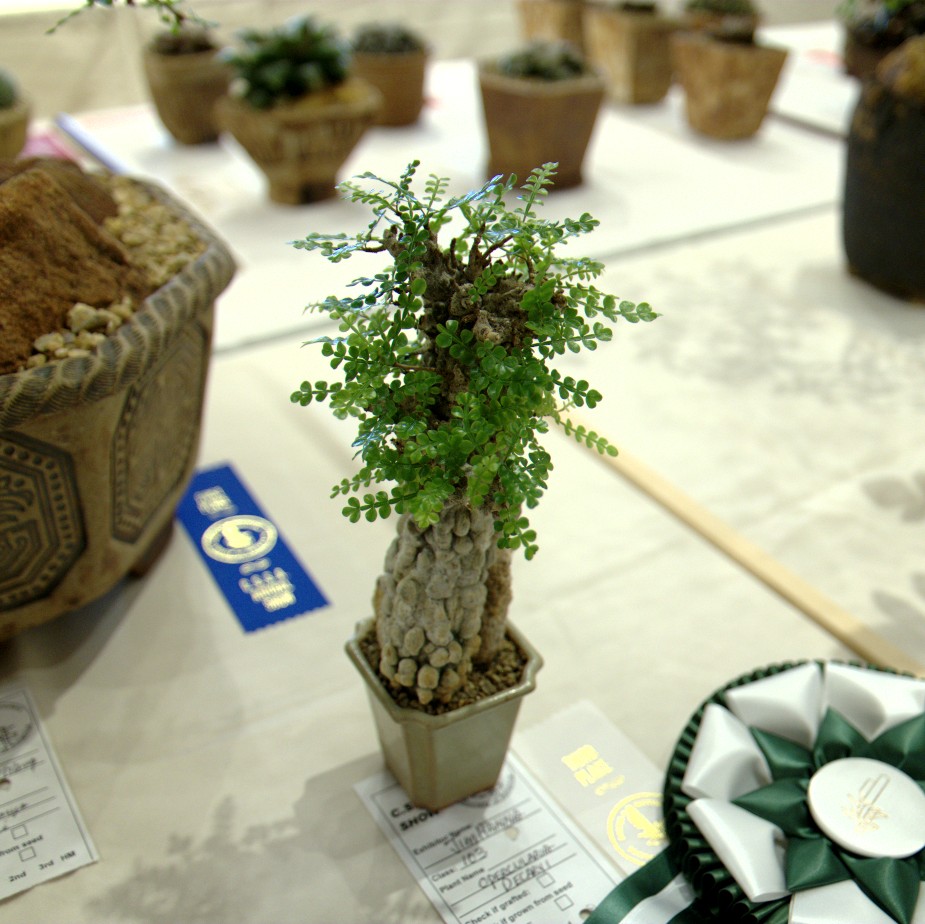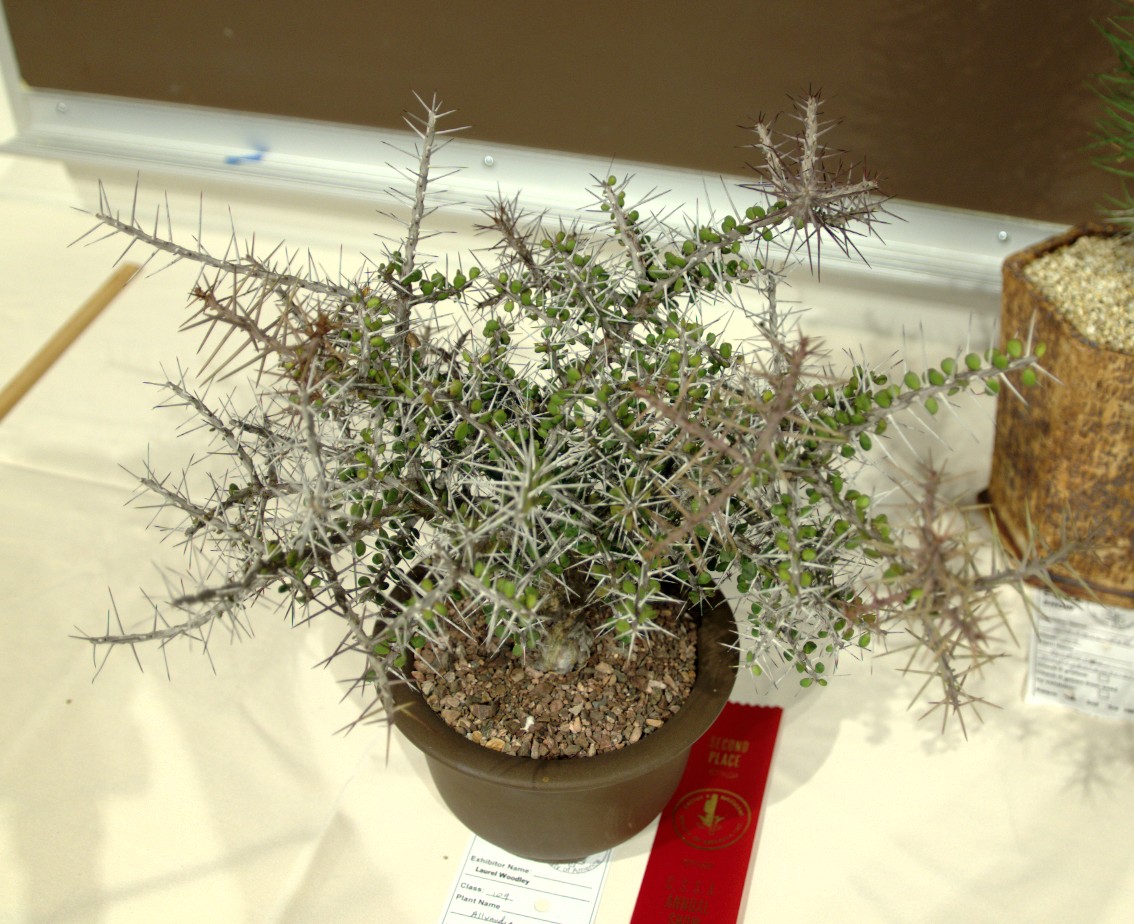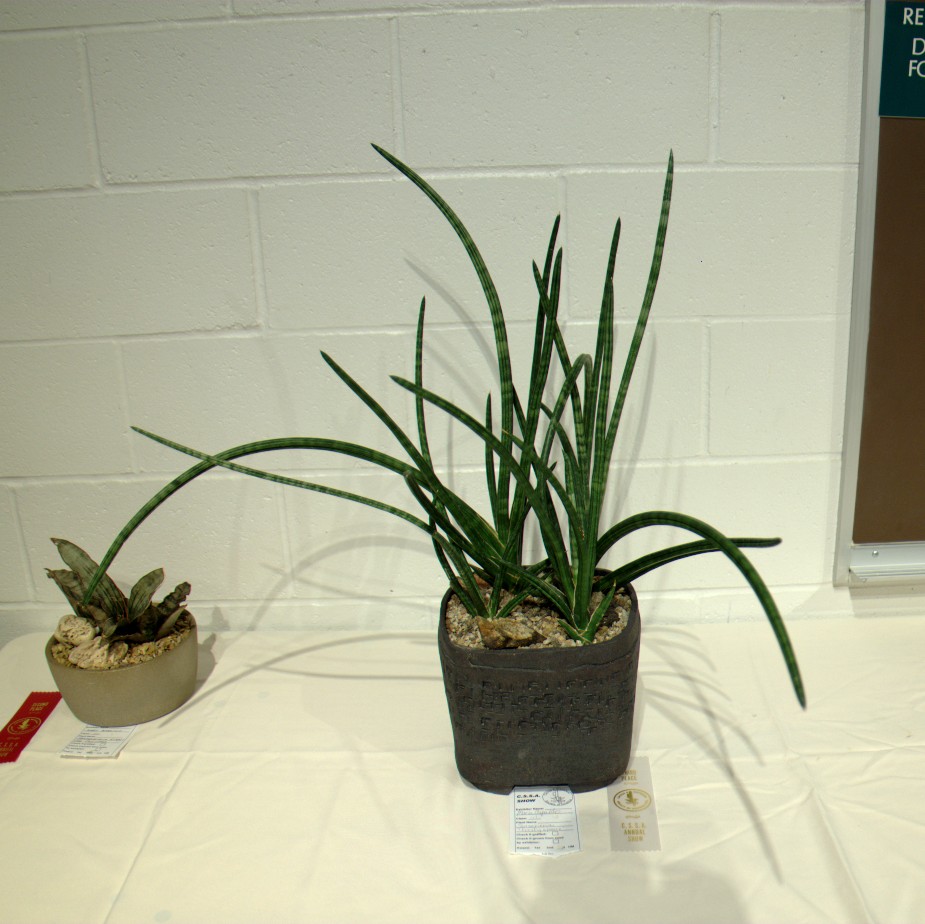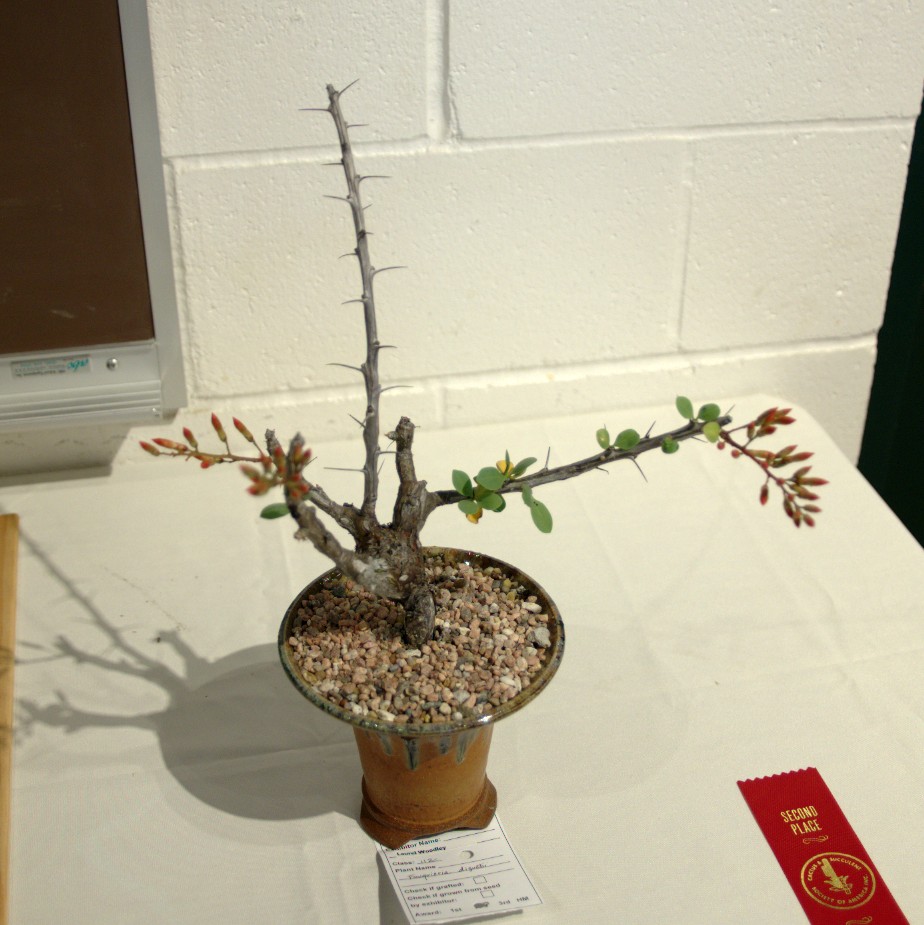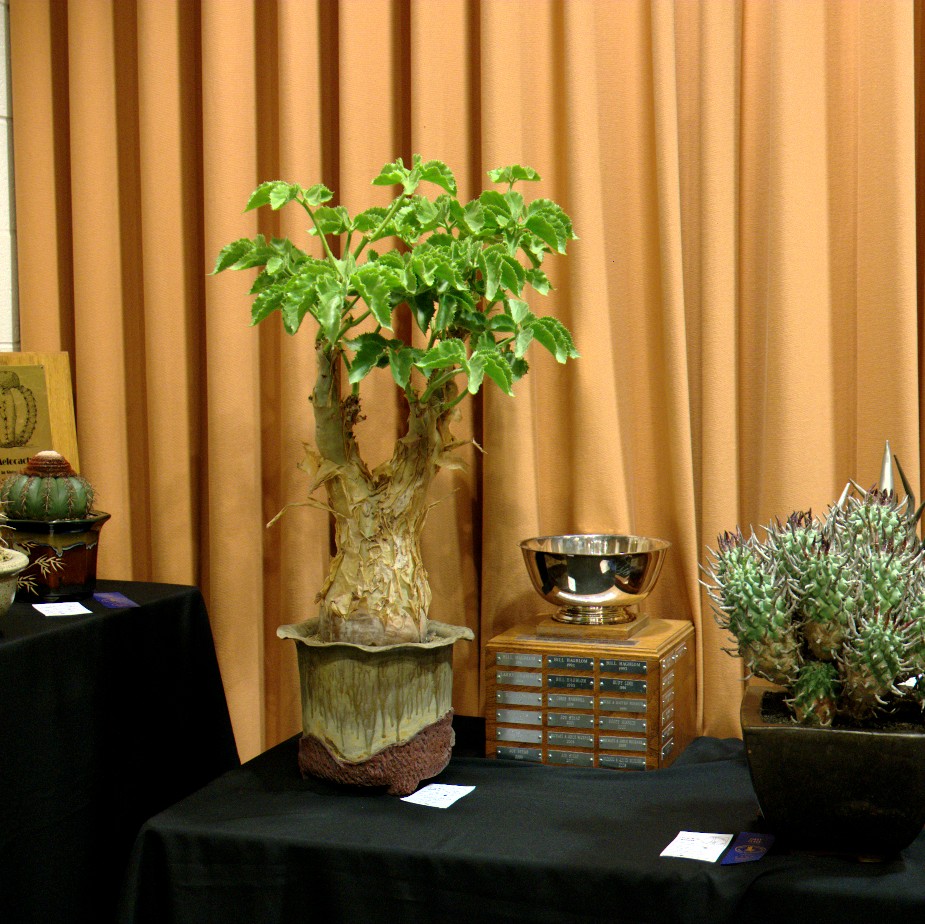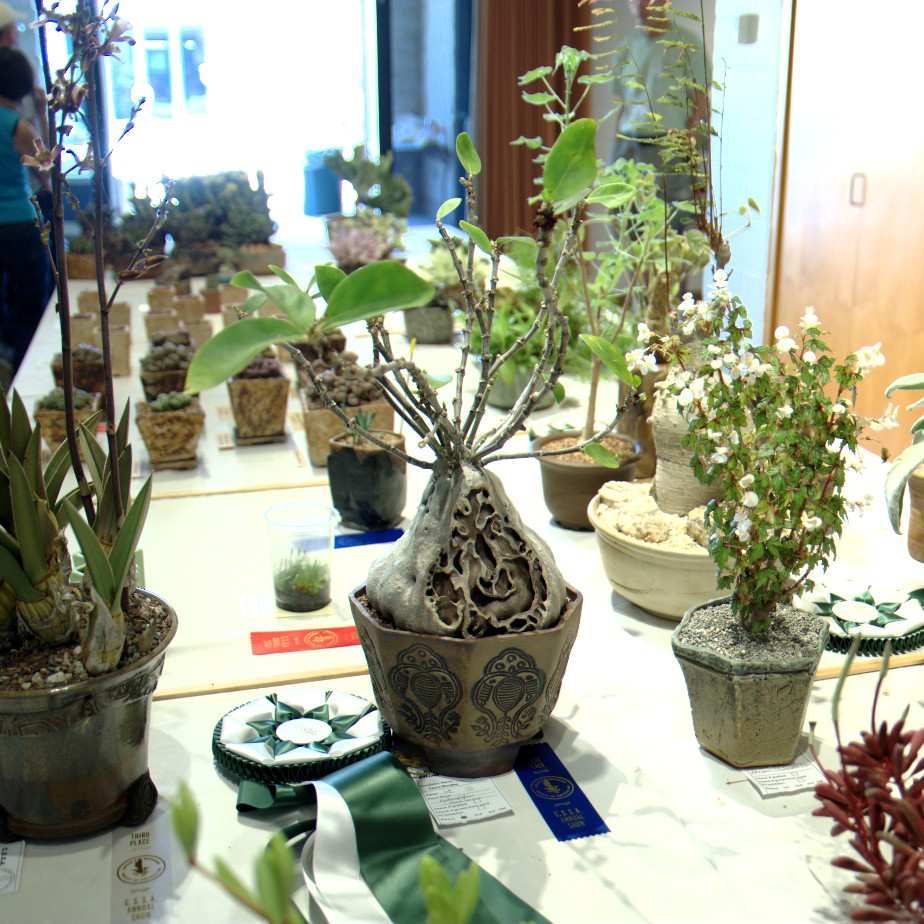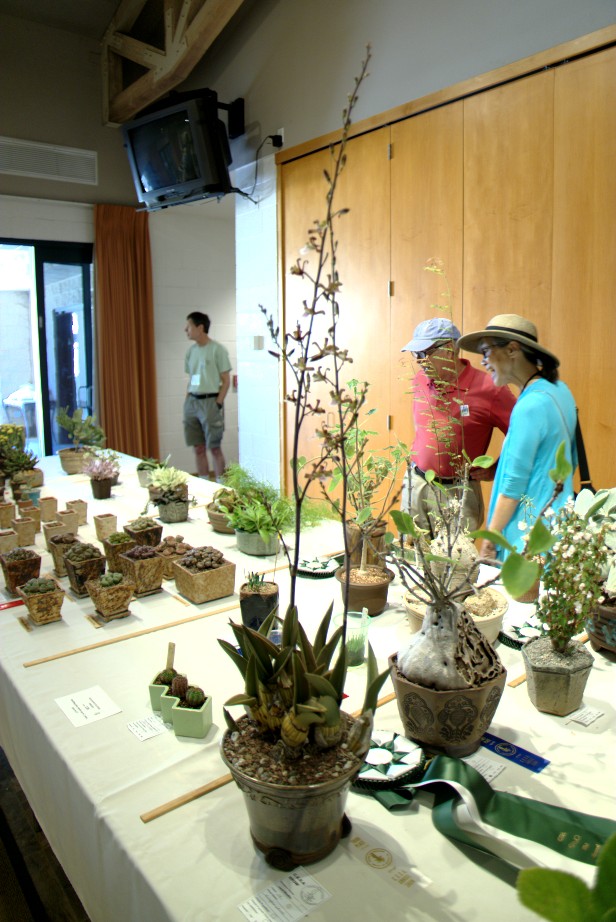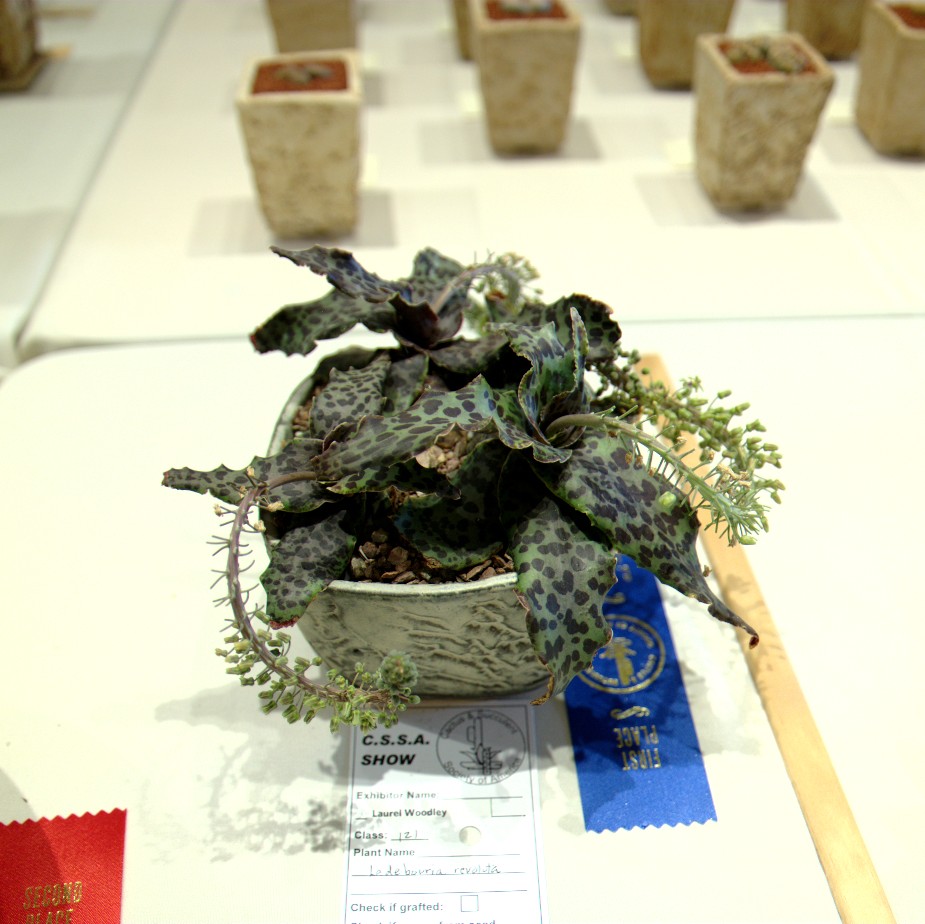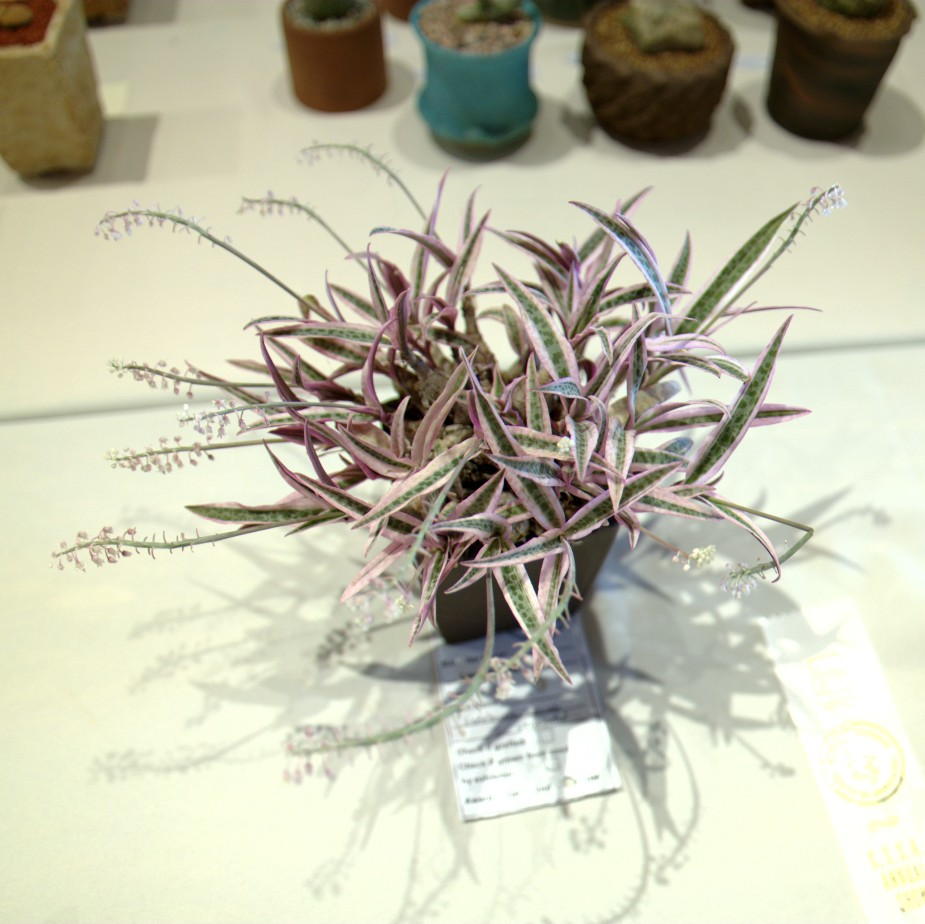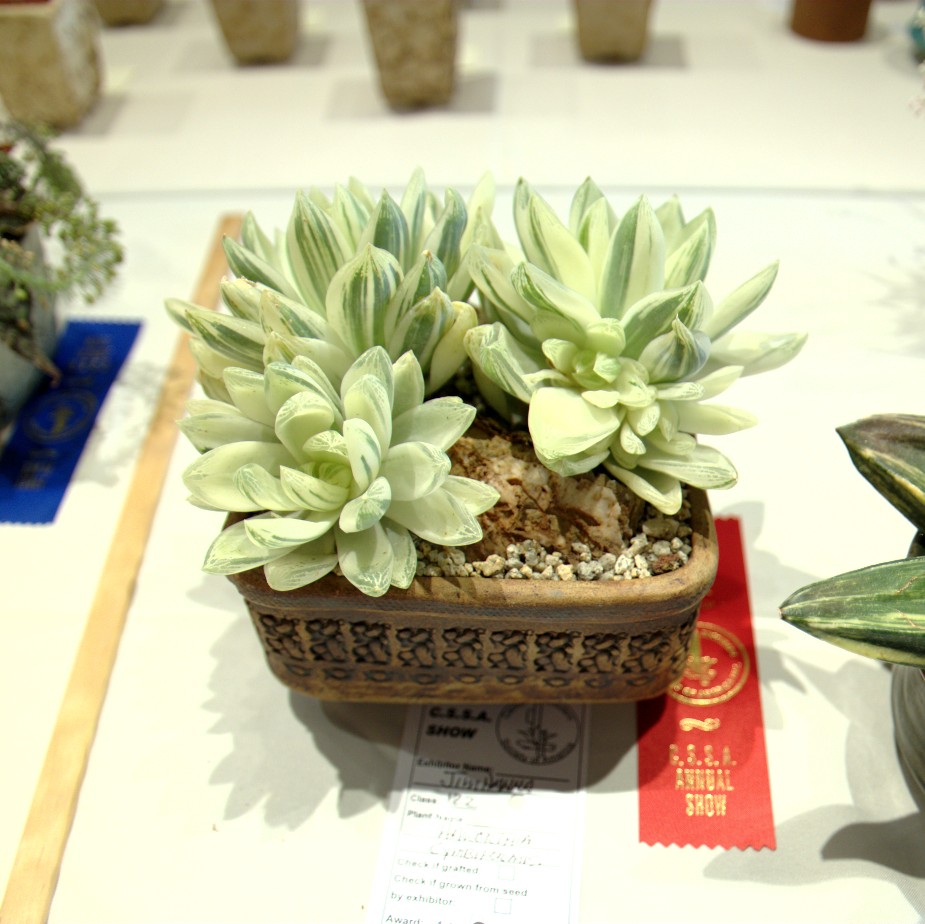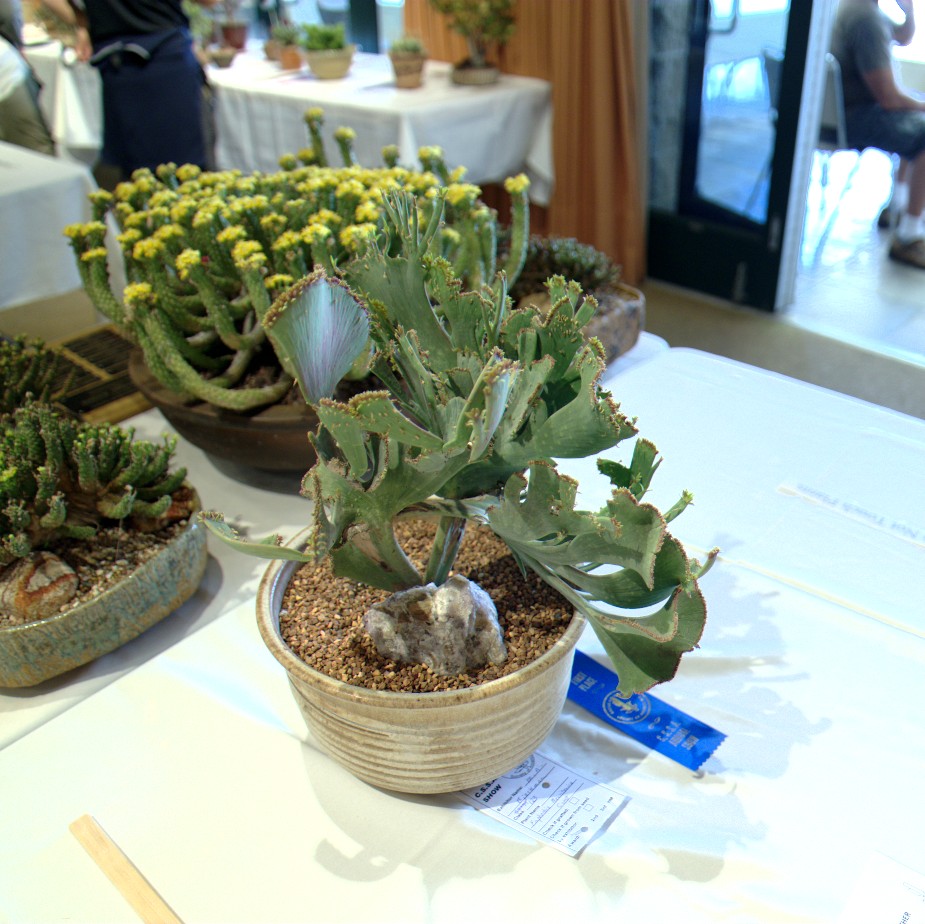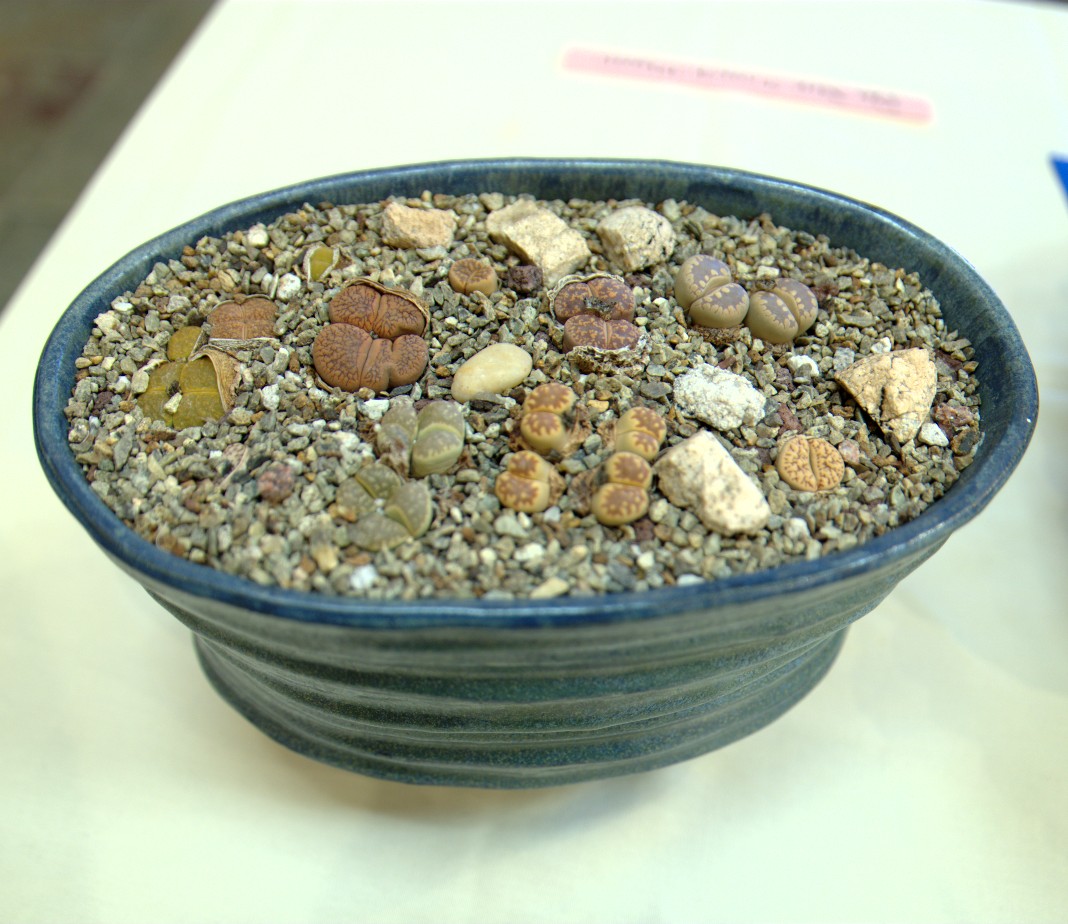SCCSS members showed well at the CSSA 2016 Show and Sale at the Huntington Library.
Some 50 first, second, or third places were awarded, and 5 members made it to the trophy table.
Kudos to M.A. Bjarkman for her best in show Aeonium, class 57.
Kudos to Maria Capaldo for her best in show Agave, class 98.
Kudos to Gary Duke for his best in show Echinocereus, class 8.
Kudos to Jim Hanna for his best in show Cyphostemma, class 118, which also was awarded ‘Best in Show’ overall.
Kudos to Laurel Woodley for her best in show Aloe, class 89.
Jump to Sortable Table
Jump to Latin Lookup
Below are photos of the placed plants. Apologies to the owners of any that were missed.
| Class | Place | Name | Plant |
|---|---|---|---|
| 4 | 3rd | Gary Duke | Acharagma roseana |
| 5 | 1st | Gary Duke | Epithelantha micromeris |
| 8 | 1st | Gary Duke | Echinocereus triglochidiatus |
| 11 | 1st | Gary Duke | Stenocactus crispatus 'Huizache Form' |
| 28 | 3rd | Gary Duke | Gymnocalycium mihanovichii |
| 30 | 1st | Gary Duke | Coleocephalocereus aureus |
| 36 | 1st | Gary Duke | Eriosyce aurata ihotzkyanae |
| 36 | 2nd | Gary Duke | Neoporteria nidus f senilis |
| 40 | 2nd | Gary Duke | Notocactus schumanniana |
| 44 | 1st | Gary Duke | Copiapoa cinerea |
| 53 | 2nd | Mike Short | Crassula capitella ssp thyrsiflora |
| 54 | 3rd | Laurel Woodley | Adromischus cristatus |
| 55 | 1st | Laurel Woodley | Kalanchoe synsepala f dissecta |
| 55 | 2nd | MA Bjarkman | Kalanchoe tomentosa |
| 55 | 3rd | Laurel Woodley | Kalanchoe tomentosa 'Chocolate' |
| 55 | 3rd | MA Bjarkman | Cotyledon tomentosa |
| 56 | 1st | Gary Duke | Tylecodon bucholzianus |
| 56 | 3rd | Gary Duke | Tylecodon stenocaulis |
| 57 | 1st | MA Bjarkman | Aeonium arboreum 'Short Chocolate' |
| 58 | 3rd | MA Bjarkman | Echeveria agavoides |
| 58 | 3rd | Maria Capaldo | Echeveria agavoides |
| 59 | 1st | Jim Hanna | Echeveria 'Etna' |
| 62 | 1st | Mike Short | Sempervivum arachnoideum |
| 62 | 2nd | MA Bjarkman | Sedum furfuraceum |
| 65 | 3rd | Laurel Woodley | Conophytum blandum |
| 66 | 3rd | Jim Hanna | Faucaria tuberculosa 'Sato' |
| 68 | 1st | Jim Hanna | Trichodiadema bulbosum |
| 68 | 2nd | Jim Hanna | Mestoklema arboriforme |
| 74 | 1st | Jim Hanna | Euphorbia stellata |
| 77 | 3rd | Maria Capaldo | Euphorbia pubiglans |
| 82 | 3rd | Jim Hanna | Fockea edulis |
| 87 | 3rd | Jim Hanna | Aloe castilloniae |
| 88 | 1st | Maria Capaldo | Aloe dorotheae |
| 89 | 1st | Laurel Woodley | Aloe 'Marsha Layhew' |
| 92 | 1st | Jim Hanna | Haworthia 'Bev's Wonder' |
| 92 | 2nd | Jim Hanna | Haworthia comptoniana x emelyae var major |
| 92 | 3rd | Gary Duke | Haworthia retusa |
| 94 | 2nd | Laurel Woodley | Gasteria rawlinsonii |
| 94 | 3rd | Maria Capaldo | Gasteria batesiana 'Super Clone' |
| 98 | 1st | Maria Capaldo | Agave victoriae-reginae |
| 103 | 3rd | Jim Hanna | Opercularia decaryi |
| 109 | 2nd | Laurel Woodley | Alluaudia comosa |
| 111 | 3rd | Maria Capaldo | Sansevieria 'Frosty Spears' |
| 112 | 2nd | Laurel Woodley | Fouquieria diguetii |
| 118 | 1st | Jim Hanna | Cyphostemma uter |
| 119 | 1st | Laurel Woodley | Hydnophytum formicarum |
| 119 | 3rd | Laurel Woodley | Eulophia petersii |
| 121 | 1st | Laurel Woodley | Ledebouria revoluta |
| 122 | 1st | Laurel Woodley | Ledebouria socialis variegata |
| 122 | 2nd | Jim Hanna | Haworthia cymbiformis |
| 123 | 1st | MA Bjarkman | Euphorbia mauritanica 'Crest' |
| 128 | 3rd | MA Bjarkman | Lithops Planter |
The meanings of latin plant names on this page – from http://davesgarden.com/guides/botanary/
- Adromischus [ad-roh-MIS-kus]
From the Greek hadros (thick or stout) and mischos (stalk), referring to the short pedicels. - Aeonium [ee-OH-nee-um]
An ancient name used by Dioscorides for one of the species in the genus. - Agave [a-GAH-vee]
Noble, handsome. - agavoides [ah-gav-OH-id-eez, ah-gav-OY-deez]
Like the genus Agave. - Alluaudia [al-loo-WAH-dee-uh]
Named for Charles Alluaud, the grandson of the politician Franois AlluaudCharles was entomologist and made many journeys to Madagascar (and other countries). He also collected plants… - Aloe [AL-oh]
From the Arabic Alloeh. - arachnoideum [a-rak-NOY-dee-um]
Spider’s web. - arboreum [ar-BOR-ee-um]
Tree-like. - aurata [aw-RAH-tuh]
Golden rays. - aureus [AW-re-us]
Golden flower. - batesiana [bate-see-AH-nuh, bate-see-AY-nuh]
Named for George Latimer Bates, 20th century American ornithologist and botanist in West Africa.. - blandum [BLAN-dum]
Pleasant, mild. - bulbosum [bul-BOH-sum]
Bulbous. - capitella [kap-ih-TEL-uh]
With small head. - cinerea [sin-EER-ee-uh]
Ash-colored. - Coleocephalocereus [koh-lee-oh-sef-uh-loh-KER-ee-us, koh-lee-oh-kef-uh-loh-SER-ee-us]
From the Greek koleos (sheath), kephale (head) and cereus (cactus). - comosa [kom-OH-suh]
Hairy. - comptoniana [komp-toh-nee-AH-nuh]
Named for the Compton family of Newby Hall, Yorkshire. - Conophytum [koh-no-FY-tum]
From the Grek konos (cone) and phyton (plant), referring to the cone shape of the plant. - Copiapoa [koh-pee-uh-POH-uh]
Of or from Copiap (Chile). - Cotyledon [kot-EE-lee-don]
Joint socket, cavity. - Crassula [KRASS-oo-la, KRASS-uh-la]
Somewhat thickened foliage; diminutive of the Latin crassus (thick, fleshy). - crispatus [kriss-pah-tuss]
Having a wavy edge. - cristatus [kris-TAY-tus]
Crested. - cymbiformis [sim-BIH-for-miss]
Boat-shaped. - Cyphostemma [sy-foh-STEM-uh]
From the Greek kyphos (tumor, hump) and stemma (garland, crown). - decaryi [de-KAR-yee]
Named for Raymond Decary, 20th century plant collector. - diguetii [dee-GWEE-tee-eye]
Named for Leon Diguet, a 19th century French chemist who explored the pearl fisheries on Santa Catalina Island, California. - dissecta [dy-SEK-tuh]
Dissected. - dorotheae [dor-uh-THEE-ay]
Named for Dr. Dorothea Christina van Huyssteen. - Echeveria [ech-eh-VER-ee-a, ech-eh-ver-EE-a]
Named for Anastasio Echeverria y Godoy, 18th century Spanish botanist. - Echinocereus [ek-in-oh-KER-ee-us, ek-in-oh-SER-ee-us]
From the Greek echinos, (porcupine) and cereus, referring to the shape of the floral tube. - edulis [ED-yew-liss]
Edible. - emelyae [EM-el-ee-ay]
Named for Mrs. Emily Ferguson, 20th century plant collector in the Riversdale and Swellendam areas of the Republic of South Africa. - Epithelantha [ep-ith-el-LAN-tha]
From the Greek epi (upon), thele (nipple), and anthos (flower); nipple-like flowers. - Eriosyce [er-ee-oh-SY-kee]
From the Greek erion (wolly) and sykon (fig, fruit). - Eulophia [yoo-LOH-fee-uh]
Good or beautiful plume. - Euphorbia [yoo-FOR-bee-uh]
Named for Euphorbus, Greek physician to Juba II, King of Mauretania. - Faucaria [fow-KAR-ee-uh]
Jaw or throat; referring to the leaves resembling an open mouth. - Fockea [FOK-ee-uh]
Named for Dr. Focke Albers, modern-day German professor and expert on the Asclepiadaceae family. - Fouquieria [foo-KWEER-ree-uh]
Named for Pierre Edouard Fouquier, 19th century French physician. - furfuraceum [fur-fur-AH-see-um]
With a meal or scurf. - Gasteria [gas-TAIR-ee-uh]
From gaster, (belly, stomach); referring to swollen base on flower. - Gymnocalycium [jim-no-kal-LISS-ee-um]
From the Greek gymnos (naked) and kalyx (covering; calyx); the flower buds are naked. - Haworthia [ha-WORTH-ee-a]
Named for Adrian Hardy Haworth, 19th century British botanist. - Kalanchoe [kal-un-KOH-ee]
From the Chinese name for one of the species. - Ledebouria [le-de-BOR-ree-a]
Named for Karl Friedrich von Ledebour, 19th century German botanist. - Lithops [LY-thops]
Like stone. - major [MAY-jor]
Larger. - mauritanica [maw-rih-TAWN-ee-ka]
Of Mauritius, from the Mascareignes islands, (which includes Mauritius, Reunion and Rodrigues ) and is situated about 1000 kms east of Madagascar. - Mestoklema [mes-toh-KLEM-uh]
From the Greek words mestos (full) and klema (a small branch); dense branching. - mihanovichii [me-han-oh-VIK-ee-eye, my-han-oh-VIK-ee-eye]
Named for Nicolas Mihanovich, 20th century Yugoslavian shipping magnate and patron of botany. - nidus [NID-us]
Referring to a nest. - Notocactus [no-to-KAK-tus]
From the Greek ntos (south) and kaktos (cactus), referring to the plant’s native habitat in South America. - Opercularia [op-er-koo-LAY-ree-a]
Lidded; with a lid. - petersii [pee-TERS-ee-eye]
Named for Wilhelm Karl Hartwig Peters, 19th century German botanist who explored Africa. - retusa [re-TOO-suh]
Rounded and notched tip. - revoluta [re-vo-LOO-tuh]
Rolled back from margins or apex. - Sansevieria [san-se-VEER-ee-uh]
Named for Prince Raimond de Sansgrio de Sanseviero, 18th century patron of botanical expeditions. - schumanniana [shoo-mahn-ee-AH-na]
Named for Dr. Karl Moritz Schumann, 19th century German botanist, and founder of the German Cactus Society. - Sedum [SEE-dum]
Sedentary, to sit. - Sempervivum [sem-per-VEE-vum]
Always living, living forever. - senilis [SEE-nil-is]
Of an old man. - socialis [so-KEE-ah-liss, so-SEE-ah-liss]
In groups. - stellata [stell-AY-tuh]
With spreading star-like rays,starry. - Stenocactus [sten-oh-KAK-tus]
Thin cactus. - synsepala [sin-SEP-al-uh]
From the Greek syn (together, with) and sepalum (sepal). - thyrsiflora [thur-SEE-flor-uh]
Flowers arranged in a thyrse (a flower cluster with a central spike that has side branches also clustered with flowers). - tomentosa [toh-men-TOH-suh]
Covered with fine, matted hairs. - Trichodiadema [try-koh-dy-uh-DEE-ma]
From the Greek thirix (hair) and diadema (band around the head); referring to the crown of bristles on the leaf tips. - triglochidiatus [try-glo-ky-dee-AY-tus, try-glo-kid-ee-AY-tus]
From the Greek tri (three) and glochis (a point), referring to the fruit of some species. - Tylecodon [ty-lee-KOD-on]
An anagram of Cotyledon (a closely-related genus). - uter [YOO-ter]
From the Latin, meaning belly or womb. - variegata [var-ee-GAY-tuh]
Variegated. - victoriae-reginae [vik-TOR-ee-ay ree-JIN-ay-ee]
Named for Queen Victoria, 19th century monarch of Great Britain; also frequently spelled victoria-reginae.
